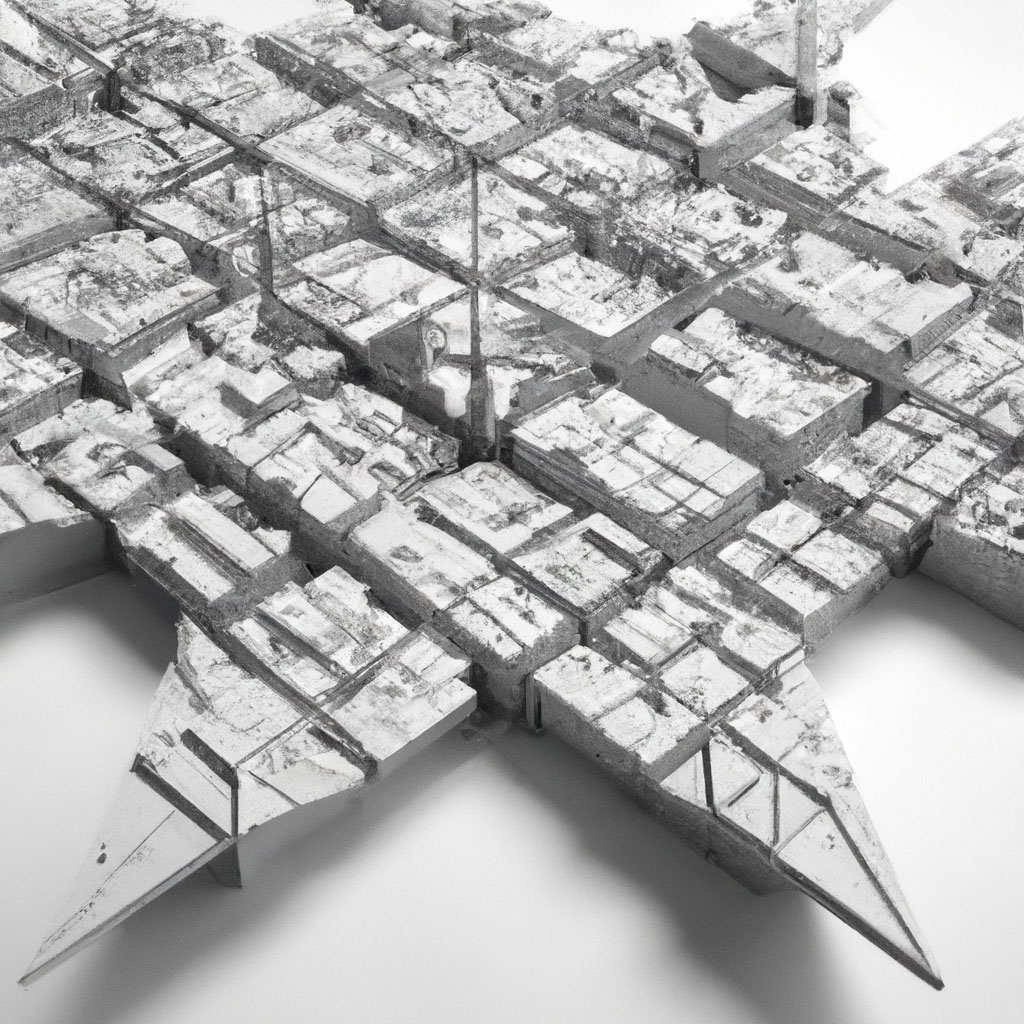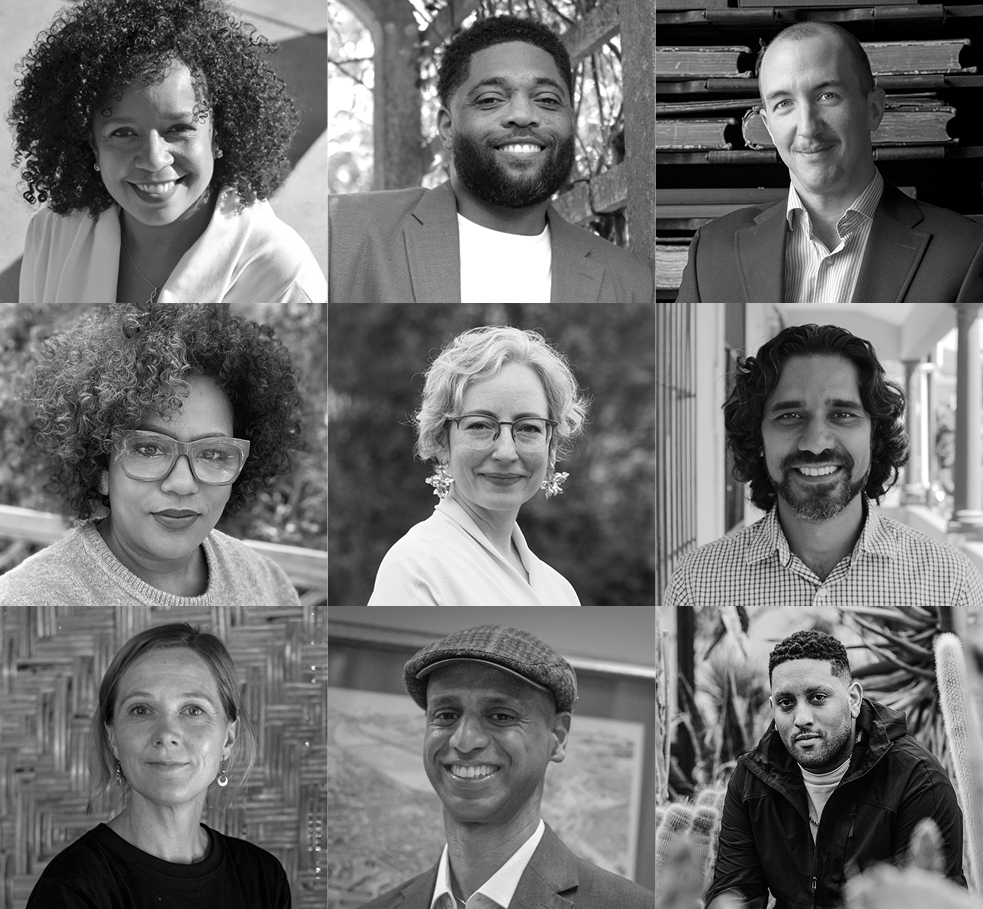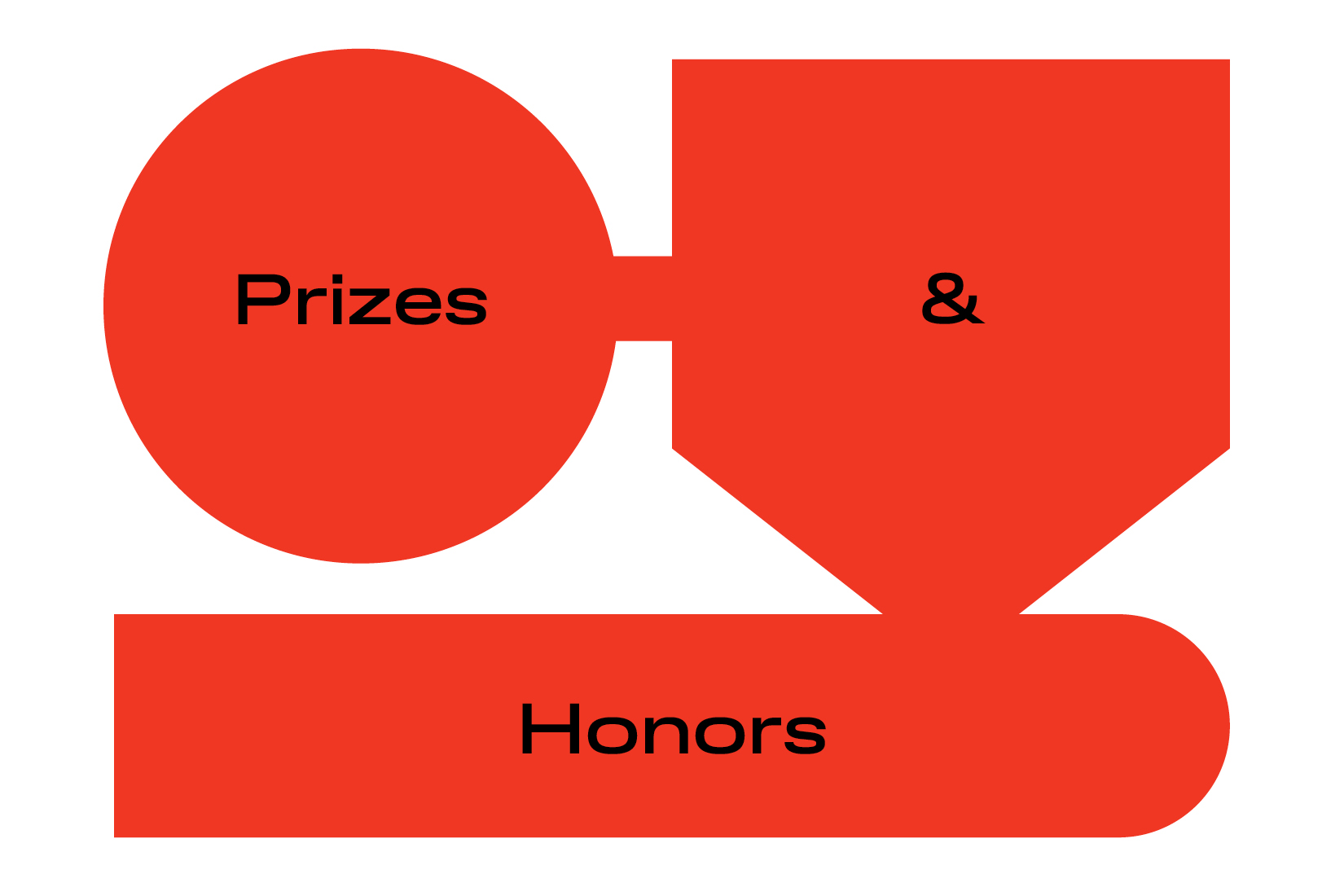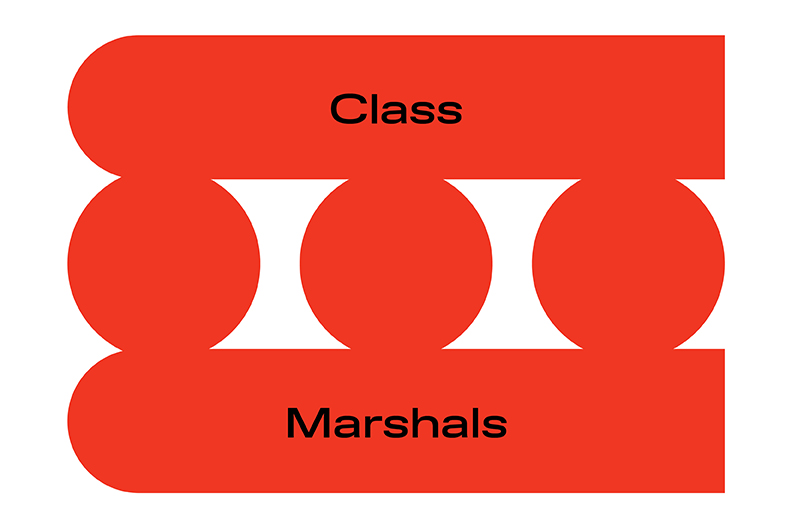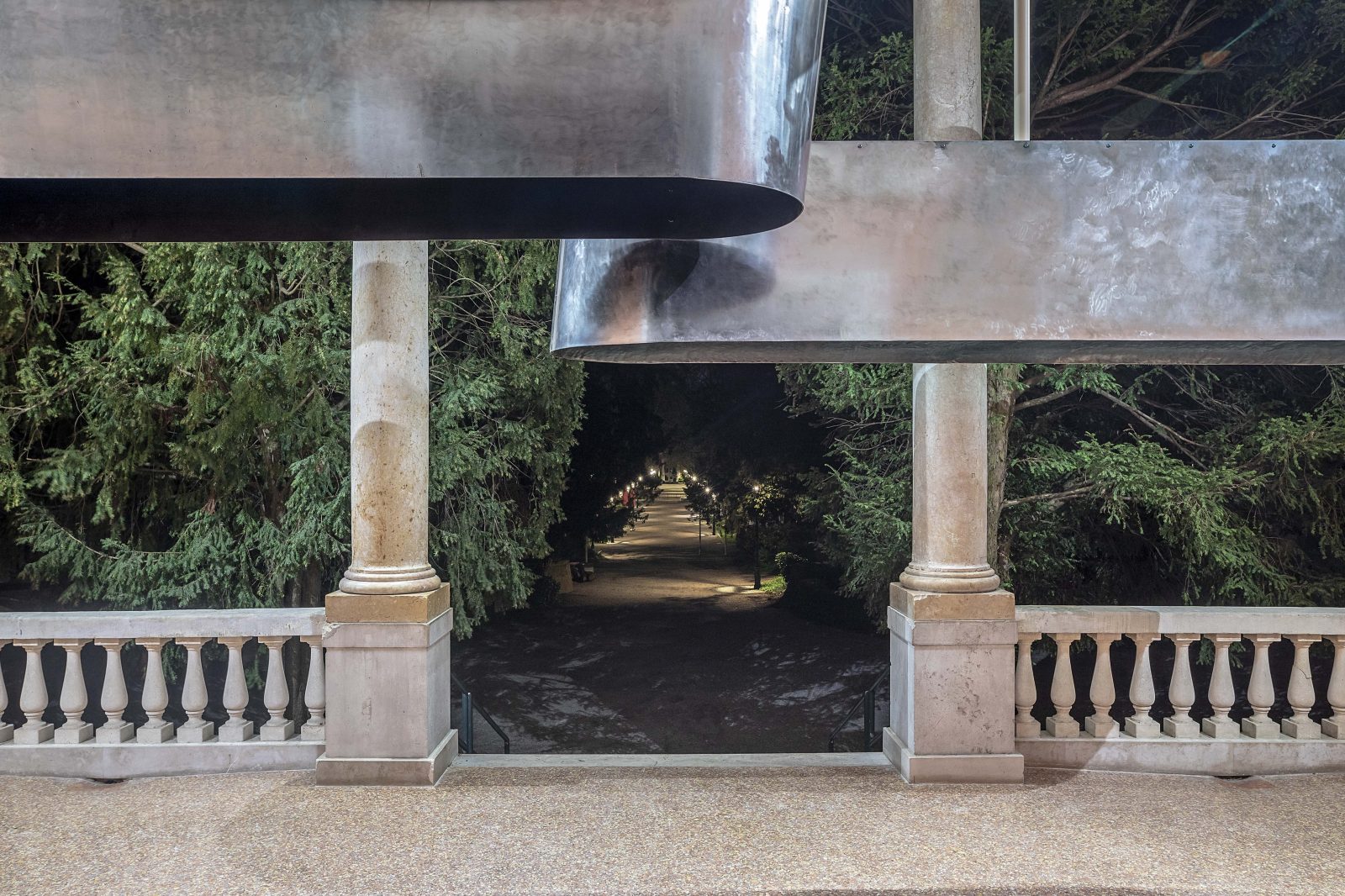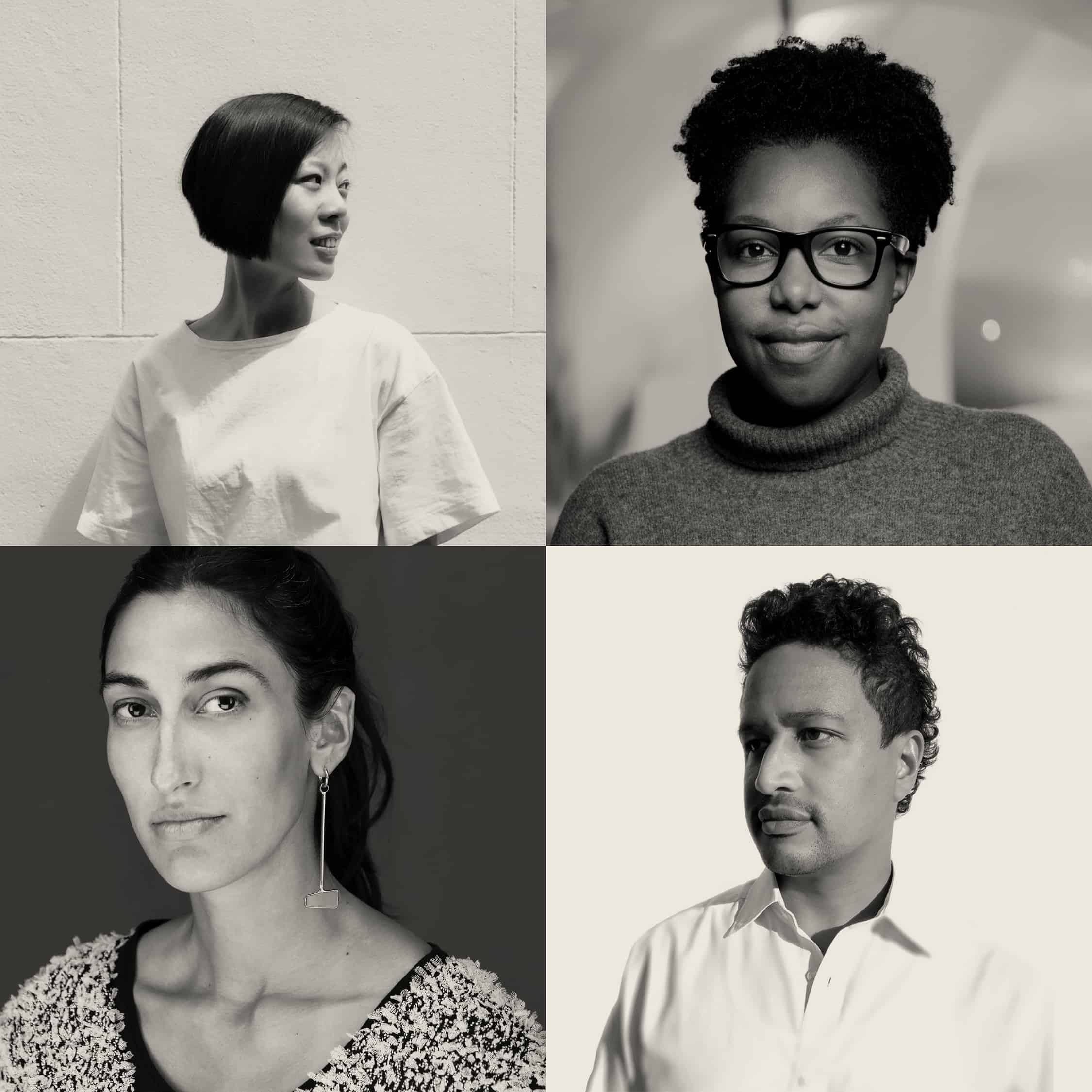Data, Digital Media, and a Different Design Office
In the summer of 2022, the nonprofit artificial intelligence group OpenAI introduced DALL-E, a groundbreaking text-to-image artificial intelligence software engine. With a prompt of a few simple words, this engine could produce dozens of photorealistic images that depicted the prompt. The popular press marveled at the striking new technology and a flood of AI-generated images, created as easily as one might make an errant comment, left some critics to ponder the future of the creative process. Architects were quick to seize on the complexities and contradictions of DALL-E with a surge of freshly generated and startlingly compelling architectural images on the one hand, and a moral panic around the implications of rapidly advancing artificial intelligence on the other. By autumn, it was clear that this technology, developed for purposes totally unrelated to architecture, was confronting architects with profound new questions around the future of design.
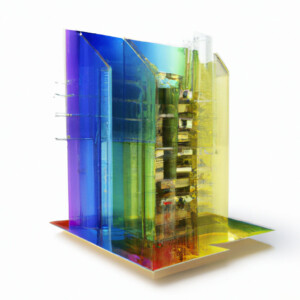
The advent of new generative AI methods seemed to resurface latent sympathies and hostilities about the role of technology, software, media, and data in architectural practice. Arguments about authorship and agency that emerged with the first application of computers to design around 50 years ago—and that seem to recur with each technological cycle—were exhumed for another ritual airing. Tacit questions about the hierarchy of design practice, such as who truly holds creative power, hovered at the margins as well. Design technology is often reflexively associated with the tooling of production labor, a means to control the execution or documentation of ideas rather than a locus of creation itself. Yet new AI systems erase the distinction between production and creation with a technology that accelerates both, a medium through which to imagine novel design ideas rather than merely a utilitarian tool to more efficiently produce drawings, images, or models. By destabilizing the typical media of representation and upending the hierarchy of creative labor, are these new technologies inimical to the foundational conventions of architectural practice?
Perhaps architectural practice needs some creative destruction. Young architecture offices have always faced challenges, from finding clients willing to trust large capital investments to untested designers with scant built work, to the risky up-front investment by architects themselves to keep a practice going until viable commissions can support the office as a business. Yet today, the classical model of a small design practice nurtured by will, pluck, and ineffable creative fervor is more precarious than ever. If the number of successful young firms is a barometer of how welcoming an industry is to innovation and generational opportunity, the architectural scene is a dismal picture. Rankings of the most financially successful architecture firms are dominated by offices with roots that date back decades. Even modest mid-sized firms—say, those with revenue in the $25–$50 million range—were founded more than 45 years ago on average, with some being twice as old.
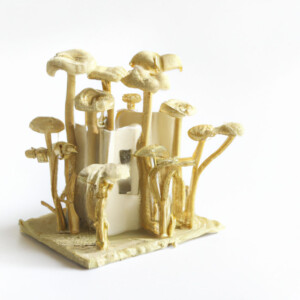
Young designers have to think in terms of decades or generations to establish their practices, while venture-backed start-ups, in contrast, think of growing to the same scale in terms of months. And while the survival rate of firms varies widely by industry, a recent estimate from the US Bureau of Labor Statistics suggests that firms in the construction space—which architecture is ultimately a part of—have among the lowest 10-year survival rates, roughly half that of health-care businesses. Moreover, within architecture, engineering, and construction, a decade of mergers and acquisitions has created a much more hegemonic and consolidated business landscape. By 2018, about half of 2008’s largest architecture, engineering, and construction firms had consolidated with others. Starting any small business has also gotten more daunting. Between 2000 and 2010, the number of new jobs created by small businesses (defined as companies of fewer than 250 employees) of any type in the United States plummeted by nearly half. Ironically, by this measure, many of the largest architecture offices in the US are still small businesses. Regardless of talent and determination, the fortunes of small design offices are dominated by macroeconomic factors and by their ability to compete in a differentiated way, and by these metrics, competition is tough indeed.
The march of digital automation is likely to cloud the picture for new practices further. The striking products of AI are only one example of how technology may restructure, democratize, and upend architectural practice and labor. Beyond manual jobs most susceptible to automation, scholars have warned that the so-called knowledge professions, including architecture, must adapt or reinvent themselves. While the most dire disruptions hinted at by newer AI technologies—massive workforce redundancy or the wholesale replacement of architects by automated tools—will likely be avoided, architects must confront these developments free of any sentimental or antiquated image of what their discipline should be.
The future health of the discipline demands deeper experimentation with alternative models of practice that embrace the opportunities of a changing cultural, technological, and economic landscape without nostalgia. To pioneer new work, young offices must be more resourceful about developing transdisciplinary approaches grounded in architecture but claiming a broader design mandate. An integrated practice that fuses design, data, and technology more holistically is not only better aligned with seismic technological and economic shifts than classical models of practice, but it is also, arguably, better placed in the contemporary cultural conversation.
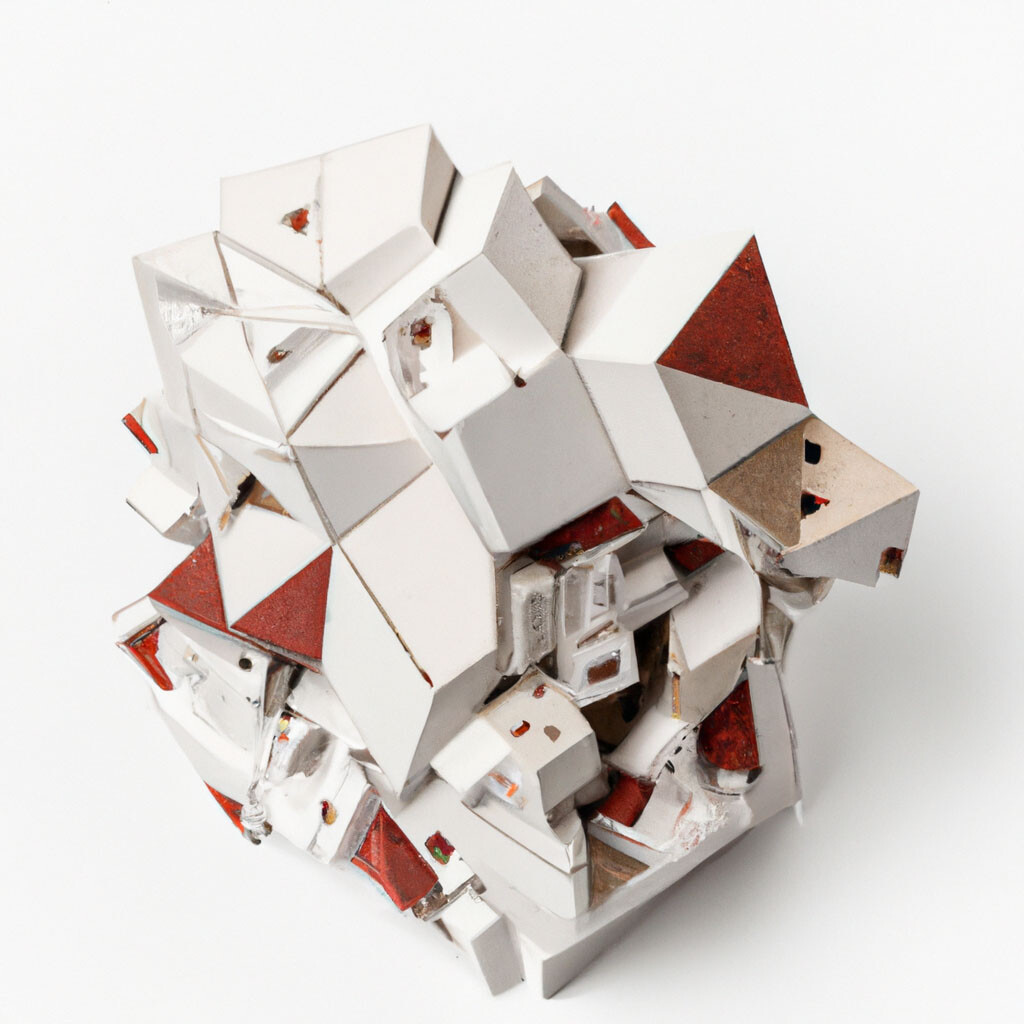
Data has become a common lingua franca among disparate disciplines and industries, and as such constitutes an indispensable mode of analysis, insight, and action around complex multidimensional problems. As vexing ecological, social, and economic issues call for systemic transformation, data can provide a common framework for understanding and action. Architects intuitively feel the need to respond to these challenges today, yet rudimentary data literacy—including topics like data sourcing, acquisition, and cleaning; data visualization; and elementary statistics—is virtually absent from architectural practice and training. If architects want to expand their impact in tackling systemic challenges and win allies as informed system designers, leveraging data is an essential tool.
Data is essential not only to inform how we deal with urgent societal and planetary challenges as a discipline, but today it is also fundamental to contemporary cultural life. In fact, by some measures, data has long surpassed architecture as a subject of popular fascination. Consider, for instance, how frequently “architecture” or “data” are mentioned in the popular press and published conversation. In the 19th century, during the initial professionalization of architecture, “architecture” and “data” appear with comparable frequency in published sources. Of course, data in the 19th century was not the electronically manipulable computational quanta we now know. When that usage became current in the 1940s, references exploded, so that by the mid-1980s, data was mentioned in published sources a staggering 60 times more frequently than architecture. Moreover, today data drives and shapes every digitally mediated interaction and is embedded in how we access and experience much of our world. There can be little doubt that data has captured the cultural imagination of the 21st century.
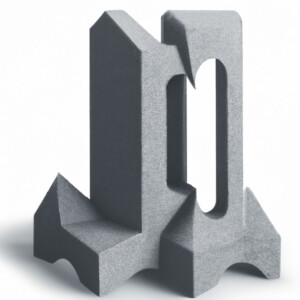
We hardly need statistics to corroborate the ubiquity of data and digital media in popular culture. Yet digital media is transforming the more elite spheres just as profoundly. One index of the burgeoning cultural influence of technology is the swelling number of institutions devoted to the intersection of design, art, and technology. Lisbon’s Museum of Art, Architecture and Technology, Basel’s HeK (Haus der Elektronischen Künste), Shanghai’s Aiiiii Art Center, Berlin’s Futurium, Dubai’s Museum of the Future, and Tokyo’s teamLab exhibition space, as well as older institutions including Karlsruhe’s ZKM and Tokyo’s InterCommunication Center and Miraikan, have all been founded in the last 20 years or so to champion the possibilities of integration of art, design, and technology. When compared to the number of new institutions devoted specifically to architecture founded in the same period, one might plausibly argue that data and digital media are more relevant as a cultural force than architecture itself.
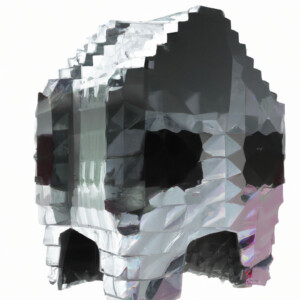
Beyond its popular and social relevance, interweaving data more deeply with design practice offers creative possibilities to address the ever expanding visual data that is an essential product of our collective society. Try as we may, human eyes and brains are finite. If one scrolled through Google Images endlessly—16 hours a day, for 80 years—one would have seen about 25 billion images, a miniscule proportion of the estimated 750 billion images on the internet, or the 1.72 trillion photographs taken every year. In training as an architect, one could not hope to see more than a few tens of thousands at an absolute limit. Data science techniques open the possibility of comparative analysis for vastly larger sets of visual data, effectively augmenting the intuition and capacity of an architect. In recent years, new tactics of data sensemaking such as machine learning and neural computation have opened up the possibility to address qualitative dimensions of visual data that were once thought to be beyond the purview of calculation—dimensions like textual descriptions or comparisons that had been the exclusive domain of architectural critics. This blurs the boundaries between the humanistic and computational techniques of analysis and criticism, and further calls into question the sacrosanct distinction between design and technique.
What, then, would a data- and media-fluent design practice that could respond to these evolutions look like? First, it would be multidisciplinary to its core, drawing people with versatile design, technical, and humanistic backgrounds capable of negotiating our world’s multidimensional design problems. Thanks to this broad disciplinary background, it could omnivorously imagine projects across scales and industries, engaging the relevant issues at a deeply strategic level. Second, it could imagine innovations in spatial design beyond the typical typologies by intersecting physical space with data-enabled ways of perceiving and understanding it. Third, it would be an office very much about making the future in tangible, physical, spatial detail, not merely visualizing possibilities digitally. It would understand the continuum between physical and digital experience as more fluid today than ever before, and that fluidity is a uniquely contemporary design opportunity. Fourth, it would embrace collaborations in many forms, engaging corporate, institutional, governmental, and cultural clients with equal relevance because it could speak the common data language of systemic challenges.
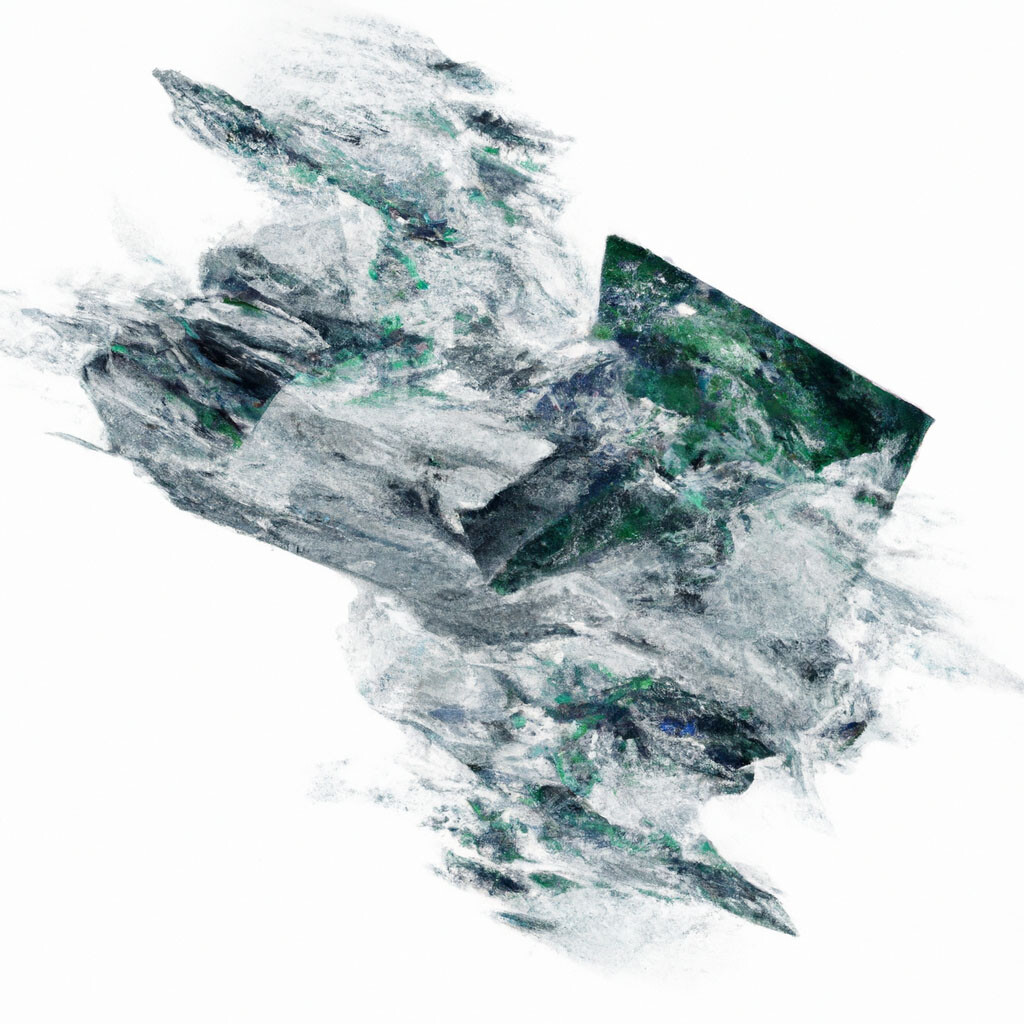
Some might protest that architecture is a generalist discipline, and that an expertise developed in media or data smacks of specialization. Yet ironically, one could argue that data science is the generalist discipline of our time, in demand and applicable in virtually every field and a veritable necessity to understand the complexities of contemporary life. By connecting spatial imagination, creative drive, and a technically synthetic approach, a young office could prototype a new kind of creative generalist.
The survival of any fledgling design venture depends on its ability to create a differentiated, valuable, and defensible expertise. While architectural methodologies and business models for young offices have remained complacently stagnant for decades, the context in which they operate has dramatically transformed. Beyond macroeconomic and technological changes, over the last 20 years, the very definition of design itself has mutated around architecture, with the advent of user-centered design, design for manufacturing, strategic design, and design futures, to name only a few. Yet architecture has remained largely oblivious to these developments, content to conform to outdated models of practice until the bitter end. To create a future for design, we must look to the challenges and opportunities of today. The data-enabled design office is no universal panacea for the ills afflicting architectural practice. Yet it might be a conduit for a richer and more vital way of practicing design—one attuned to our age and embracing the opportunities ahead.
Andrew Witt is an Associate Professor in Practice in Architecture at the GSD. Witt is also co-founder, with Tobias Nolte, of Certain Measures
, a Boston/Berlin-based design and technology studio.
GSD Faculty, Alum, and Student Win 2023 Graham Foundation Grants
Members of the Harvard Graduate School of Design (GSD) community are among recipients of new project grants from the Graham Foundation for Advanced Studies in the Fine Arts . Announced in late May, the Foundation’s 2023 grants present nearly $560,000 in funding to support 64 projects by 93 individuals and collaborators who are “working to realize innovative and interdisciplinary ideas that contribute critical perspectives on architecture and design.” The funded projects include publications, research programs, exhibitions, films, podcasts, digital initiatives, public programs, and other formats that further ideas, dialogues, and new understandings of architecture.
The GSD awardees and their projects are:
Yun Fu, Design Critic in Urban Planning and Design, for the publication Thinking and Building on Shaky Ground. Building with earthquakes is a familiar yet persistent design problem for resilient construction on all continents. The book elaborates on various factors for earthquake-resilient architecture in six thematic chapters that explore the design strategies of lightness, quickness, exactitude, visibility, multiplicity, and consistency. These factors allow designers to develop contextual solutions that marry technical know-how with social and cultural understanding, ranging in scale from buildings to furniture and urban master plans.
Dana McKinney, Design Critic in Urban Planning and Design, for Black—Still, an installation that offers an accessible entry point into architecture. Situated within the Craft Contemporary’s courtyard in Los Angeles, the reverential volumes are responsive to various obstacles beneath the surface, on the ground, and above. The prism’s glossy black finish evokes the tar running below the ground’s surface—the use of the color black frames an introspective space. Black is celebrated as “clean,” “pure,” and “good,” and is a source of collective healing. Its blackness subverts traditional and modernist notions of whiteness, presenting novel and diverse expressions of architecture.
Anna Bokov (MArch ’04) for the publication From Method to Style: Elements of Spatial Composition and Architectural Pedagogy after Vkhutemas. The publication centers on Elements of Spatial Composition, a textbook published in 1934 by a group of former Vkhutemas faculty who sought to salvage the pedagogical methods of that avant-garde school at the onset of Stalin’s stylistic mandates in the Soviet Union.
Curry J. Hackett (MAUD ’24) for Drylongso: Imaging the Black Landscape, a research project that incorporates oral histories and archival material to inform installations, writing, craft, and drawings that collectively render everyday life of Black lands in the American South. Drylongso (a Gullah-derived word meaning “ordinary” or “same old”) is an indexing and speculation of the geographies and landscapes shaped by Black cultural production. Hackett was a finalist for the 2022 Wheelwright Prize for his proposal “Drylongso: Sociospatial Tropes of the African Diaspora.”
Nahyun Hwang (MArch ’01) and David Eugin Moon (MArch ’01), of N H D M Architects, present Migrating Futures, an ongoing project that investigates the historical and contemporary geographies of diverse diaspora communities and transnational migrant workers within Korea and across Asia. While subjected to the enduring colonial legacy of subjugated and racialized laboring bodies and extremely precarious work and living conditions, the ostensibly transient global subjects shape and embody emergent and hyper-local spatial typologies, new socialities, and potently intersectional cultural and agentive capacities.
The Graham Foundation will announce grants to organizations, as well as winners of the 2023 Carter Manny Award, later this year.
Loeb Fellowship Announces Incoming Class of 2024
The Loeb Fellowship at the Harvard Graduate School of Design (GSD) has chosen the 2024 Class of Loeb Fellows: nine innovators, problem solvers, visionaries, and practitioners who lead the charge for social justice and transformative change. They work in fields as diverse as post-disaster support, cultural infrastructure, land ownership reform, and climate justice.
Every academic year, the Loeb Fellowship at Harvard GSD welcomes a new cohort of gifted mid-career professionals. They arrive from diverse backgrounds but share a passion and common purpose: to strengthen their abilities to advance equity and achieve positive social outcomes. During their 10-month residency, Loeb Fellows immerse themselves in a rich academic environment, auditing courses at Harvard and MIT, exchanging insights, and expanding professional networks. They also engage with Harvard GSD students and faculty, participate as speakers and panelists at public events, and convene workshops and other activities that encourage knowledge sharing and creation. Throughout, Loeb Fellows consider how they might refocus their careers and broaden the impact of their work.
The incoming cohort of 2024 Loeb Fellows are:
Catherine Buell
Former Director, Amazon Housing Equity Fund / Washington, DC, USA
Akeem Dixon
Founder and CEO, The Intersect / Philadelphia, PA, USA
Henry Grabar
Staff Writer, Slate / Paris, France and New York, NY, USA
Mavis Gragg
CEO, HeirShares / Durham, NC, USA
Maria-Mercedes Jaramillo Garcés
Secretary of Planning, City of Bogotá / Bogotá, Colombia
Adi Kumar
Executive Director, Ndifuna Ukwazi / Cape Town, South Africa
Line Ramstad
Founder and Director, Gyaw Gyaw / Vormsund, Norway
Kannan Thiruvengadam
Director, Eastie Farm, Inc. / Boston, MA, USA
Joseph Zeal-Henry
Co-Founder, SOUND ADVICE and Capital Development Manager, Greater London Authority / London, UK 2024 Loeb/ArtLab Fellow
“Every year, Loeb Fellows add a special, irreplaceable energy to the GSD community. They come from all over the world, bringing with them such rich and varied experiences and an ambitious optimism that opens our eyes to what’s possible. At the GSD, we are incredibly fortunate to count them among us, and I can’t wait to welcome next year’s class in Cambridge,” says Sarah M. Whiting, Dean and Josep Lluís Sert Professor of Architecture at the GSD.
“When the Selection Committee makes its decision in the spring, we already know these individuals are highly accomplished and show great promise for growing their influence,” observes Loeb Fellowship Curator John Peterson. “Our work is to recognize the opportunity this educational experience presents for and the catalyzing effect being within the cohort has on their potential.” Peterson is an architect, activist, and curator of the Loeb Fellowship program.
After their year of Harvard GSD residence, Loeb Fellowship alumni join a powerful worldwide network of over 450 lifelong Loeb Fellows. Many are recognized leaders, like Theaster Gates (LF ’11), Toni Griffin (LF ’98), Alessandro Petti (LF ’17), Emmanuel Pratt (LF ’17), Ana María Durán Calisto (LF ’11), Stephanie Hankey (LF ’22), Michael Uwemedimo (LF ’22), Jordan Weber (LF ’22), and Mpho Matsipa (LF ’22), all of whom are represented at the Venice Biennale Architettura 2023. Tau Tavengwa (LF ’18) is on the Biennale Jury, and incoming Loeb Fellow Joseph Zeal-Henry is a co-curator of the British Pavilion 2023.
The Loeb Fellowship continues its collaboration with the ArtLab at Harvard University to welcome Joseph Zeal-Henry as its 2024 Loeb/ArtLab Fellow. Zeal-Henry will have access to studio space and will be able to engage with the ArtLab community and its intellectual resources and networks. As the third Loeb/ArtLab Fellow, he joins past Artist Fellows Jordan Weber (LF ’22) and Dario Calmese (LF ’23).
ArtLab Director Bree Edwards says, “I am excited to have Joseph Zeal-Henry join us as he investigates how arts and culture are central to urban planning and policy. Joseph’s cross-sector research, storytelling, and the innovative ways he brings people together align with the mission of ArtLab.”
The Loeb Fellowship traces its roots to the late 1960s, when John L. Loeb directed a Harvard GSD campaign based on the theme of “Crisis.” Loeb saw the American city in disarray and believed Harvard could help. He imagined bringing promising innovators of the built and natural environment to Harvard GSD for a year, challenging them to do more and do better, convinced they would return to their work with new ideas and energy.
John L. and Frances Loeb endowed the Loeb Fellowship as part of their gift to the “Crisis” campaign. They worked closely with William A. Doebele, the Frank Backus Williams Professor of Urban Planning and Design (now Emeritus), the program’s founding curator, who guided the program from the Class of 1971 until 1998, and shaped an experience that has had a powerful impact on generations of urban, rural, and environmental practitioners.
Prizes & Honors 2023
Each year at commencement, the Harvard Graduate School of Design confers awards on graduating students who demonstrate exceptional scholarly achievement, leadership, and service. Congratulations to the student award recipients, and to all of the 2023 graduates for your tremendous accomplishments.
School-wide Awards
Gerald M. McCue Medal
The Gerald M. McCue Medal is awarded each year to the student graduating from one of the school’s post-professional degree programs who has achieved the highest overall academic record.
- Oonagh Saskia Binnie Davis (MArch II ’23)
Digital Design Prize
The Digital Design Prize is presented by the Graduate School of Design to the students who have demonstrated the most imaginative and creative use of computer graphics in relation to the design professions.
- Amelia Wen Jiun Gan (MDes ’23, Mediums Domain)
- Sonia Sobrino Ralston (MLA I AP ’23)
Peter Rice Prize
The Peter Rice Prize honors students of exceptional promise in the school’s architecture and advanced degree programs who have proven their competence and innovation in advancing architecture and structural engineering.
- Sujie Park (MArch I ’23)
Plimpton-Poorvu Design Prize
The Plimpton-Poorvu Design Prize recognizes the top team or individual for a viable real estate project completed as part of the GSD curriculum that best demonstrates feasibility in design, construction, economics, and in fulfillment of market and user needs.
- 1st Prize: Pinyang Chen (MLAUD ’23)
- 1st Prize: Vivian Cheng (MAUD ’23)
- 1st Prize: Cheryl Lin (MArch II ’24)
- for their submission, The Gansevorrt: Design for Longevity
- 2nd Prize: Madeleine Jade Levin (MUP ’23)
- 2nd Prize: Arielle Raine Rawlings (MUP ’23)
- 2nd Prize: Maddie Farrer (MArch I ’25)
- for their submission, Boyd Street Gateway
- Honorable Mention: Taerie Kim (MUP ’23)
- Honorable Mention: Claire Jing Hui Tham (MUP ’23)
- Honorable Mention: Heejin Park (MAUD ’23)
- Honorable Mention: Lai Zhou (MDes ’23, Publics Domain)
- Honorable Mention: Aelin Li (MDes ’24, Narratives Domain)
- for their submission, Truly, Oregon! Empower Lloyd Center, Portland, OR
Clifford Wong Prize in Housing Design
The Clifford Wong Prize in Housing Design aims to help re-establish the essential role of architects in society to provide not only the fundamental needs of human shelter but to meet the challenge of designing creative solutions for improving living environments. The Prize is awarded for the multi-family housing design that incorporates the most interesting ideas and/or innovations that may lead to socially-oriented, improved living conditions.
- Randy Crandon (MArch I ’25)
- Maddie Farer (MArch I ’25)
Alumni Award
The Alumni Award recognizes and celebrates the diversity, range, and impact of outstanding GSD alumni leaders within their communities and across their areas of practice. It underscores the essential role GSD graduates play in leading change around the world.
- Edwin Cruz (MDes ’97)
- Shaun Donovan (BA ’87, MPA ’71, MArch ’95)
- William Johnson (MLA ’57)
- Frank Christopher Lee (MAUD ’79)
- Cathy Simon (MArch ’69)
Irving Innovation Fellowship
The Irving Innovation Fellowship offers a graduating student the opportunity to extend their research and discovery beyond their time as a student and work with a group of mentors and colleagues to contribute to the school’s pedagogy and dialogue on an annually changing topic.
- Amelia Wen Jiun Gan (MDes ’23, Mediums Domain)
Sinclair Kennedy Traveling Fellowship
The Sinclair Kennedy Traveling Fellowships support a full academic year of research at destinations outside of the United States.
- Sharon Michelle Welch (MDes ’23, Publics Domain)
Fulbright Grants
The Fulbright US Student Program is an international exchange program in the fields of education, culture, and science, offering advanced research, study, and teaching opportunities in over 140 countries.
- Tomi Seyi Laja (MArch II ’23)
- Julia Cheryl Meinhardt (MUP ’23)
Architecture Awards
American Institute of Architects Medal
The American Institute of Architects Medal is awarded to a professional degree student in the Master in Architecture graduating class who has achieved the highest level of excellence in overall scholarship throughout the course of their studies.
- Kaitlynn Ann Long (MArch I ’23)
Alpha Rho Chi Medal
The Alpha Rho Chi Medal is awarded to the graduating student who has achieved the best general record of leadership and service to the department and who gives promise of professional merit through their character.
- Daniel Haidermota (MArch I ’23)
- Leonard E. Palmer (MArch I ’23)
James Templeton Kelley Prize
The James Templeton Kelley Prize recognizes the best final design project submitted by a graduating student in the architecture degree programs.
- MArch I: Jacqueline Wong Huey Yean (MArch I ’23)
- MArch II: Deok Kyu Chung (MArch II ’23)
Julia Amory Appleton Traveling Fellowship in Architecture
The Julia Amory Appleton Traveling Fellowship is given to a student in the Department of Architecture on the basis of academic achievement as well as the worthiness of the project to be undertaken.
- Yijia Tang (MArch I ’23)
Kevin V. Kieran Prize
The Kevin V. Kieran Prize recognizes the highest level of academic achievement among students graduating from the post-professional Master in Architecture program.
- Oonagh Saskia Binnie Davis (MArch II ’23)
Dept. of Architecture Faculty Design Award
The Department of Architecture Faculty Design Award was established by the faculty of the Department of Architecture with the aim of recognizing significant achievement within a body of design work completed by a student at the GSD. This award is given to graduating students from each of the department’s two program.
- Ashleigh-Paige Fielding (MArch I ’23)
- Pablo Castillo Luna (MArch II ’23)
Dept. of Architecture Certificate of Academic Excellence
The Department of Architecture Certificate of Academic Excellence is awarded by the faculty of the Department of Architecture to a graduate of the professional degree program in architecture (MArch I) in recognition of their academic achievement throughout their course of study in the program.
- Ashleigh-Paige Fielding (MArch I ’23)
Landscape Architecture Awards
Thesis Prize in Landscape Architecture
The Landscape Architecture Thesis Prize is given to the graduating student who has prepared the best independent thesis during the past academic year.
- Sonia Sobrino Ralston (MLA I AP ’23)
- Kevin Thomas Robishaw (MLA I ’23)
- Celina Chinyere Abba (MLA I AP ’23)
- Enrique Cavelier (MLA I AP ’23)
American Society of Landscape Architects Certificates
Nominated by the faculty in the GSD’s Department of Landscape Architecture, the American Society of Landscape Architects (ASLA) awards a certificate of Honor and a Certificate of Merit to students enrolled in the Master in Landscape Architecture program who have “demonstrated a high degree of academic scholarship and of accomplishment in skills related to the art and technology of landscape architecture.”
- Tian Wei Li (MLA I and MDes ’23), Certificate of Merit
- Riley Warren Nystrom (MLA II ’23), Certificate of Merit
- Pitchapa Setpakdee (MLA II ’23), Certificate of Merit
- Enrique Cavelier (MLA I AP ’23), Certificate of Honor
- Dian Xi Diana Guo (MLA I and MDes ’23), Certificate of Honor
- Justin Patrick Hailey (MLA II ’23), Certificate of Honor
Landscape Architecture Foundation Olmsted Scholar
Each year the faculty in the Department of Landscape Architecture nominates a student for the Landscape Architecture Foundation Olmsted Scholars Program. The program recognizes and supports students with exceptional leadership potential.
- Celina Chinyere Abba (MLA I AP ’23)
Norman T. Newton Prize
The Norman T. Newton Prize is given to a graduating landscape architecture student whose work best exemplifies achievement in design expression as realized in any medium.
- Sonia Sobrino Ralston (MLA I AP ’23)
Peter Walker & Partners Fellowship for Landscape Architecture
The Peter Walker and Partners Fellowship for Landscape Architecture is awarded to support travel and study for a graduating GSD student to advance their understanding of the body of scholarship and practices related to landscape design.
- Pavin Banternghansa (MLA I AP ’23)
- Lara Trimarco Prebble (MLA I ’23)
Jacob Weidenmann Prize
The Jacob Weidenmann Prize is awarded to the student of the most distinguished design achievement graduating from the Department of Landscape Architecture.
- Kevin Thomas Robishaw (MLA I ’23)
Charles Eliot Traveling Fellowship in Landscape Architecture
The Charles Eliot Traveling Fellowship is awarded annually as the highest honor by the Department of Landscape Architecture to one of its graduates.
- Celina Chinyere Abba (MLA I AP ’23)
Urban Planning and Design Awards
The Award for Academic Excellence in Urban Planning and Urban Design honors graduating students from each of the programs who have achieved the highest academic record.
Academic Excellence in Urban Planning
- Elizabeth Houston Sheild (MUP ’23)
Academic Excellence in Urban Design
- Sarah Elizabeth Page (MAUD ’23)
Award for Outstanding Leadership in Urban Planning and Urban Design
The Award for Outstanding Leadership in Urban Planning and Urban Design honors graduating students from each of the programs who have demonstrated outstanding leadership during their time at the Graduate School of Design.
- Abdul-Razak Mohammed Zachariah (MUP ’23)
- Sikun Lamei Zhang (MUP ’23)
- Rolando Girodengo Lobo (MAUD ’23)
Thesis Prizes in Urban Planning and Urban Design
Planning and Design Thesis Prize is given to the graduating students in each of the programs who have prepared the best independent theses during the past academic year.
- Michael Patrick Zajakowski Uhll (MUP ’23)
- Saad Boujane (MAUD ’23)
The Award for Excellence in Project-Based Urban Planning
The Award for Excellence in Project-Based Urban Planning is given to students who have demonstrated exceptional ability in urban planning projects including research and design studios throughout their course of study.
- Jonathan Yedahm Lee (MUP ’23)
The Award for Excellence in Urban Design
The Award for Excellence in Urban Design is given to students who have demonstrated exceptional design ability throughout their course of study in the Urban Design program.
- Sarahdjane Mortimer (MAUD ’23)
American Institute of Certified Planners Outstanding Student Award
The American Institute of Certified Planners Outstanding Student Award recognizes outstanding attainment in the study of planning by students graduating from accredited planning programs. The recipient of the award is chosen by a jury of planning faculty at each school.
- Mary Claire Abbott (MUP ’23)
Ferdinand Colloredo-Mansfeld Prize for Superior Achievement in Real Estate Studies
The Ferdinand Colloredo-Mansfeld Prize for Superior Achievement in Real Estate Studies is awarded annually to a graduating student from any program who has exhibited superior academic accomplishment and leadership in real estate studies.
- Pinyang Chen (MLAUD ’23)
- Elizabeth Houston Sheild (MUP ’23)
Druker Traveling Fellowship
Established in 1986, The Druker Traveling Fellowship is open to all students at the GSD who demonstrate excellence in the design of urban environments. It offers students the opportunity to travel in the United States or abroad to pursue study that advances understanding of urban design.
- Sarah Elizabeth Page (MAUD ’22)
Design Studies Awards
Dimitris Pikionis Award
The Dimitris Pikionis Award recognizes a student for outstanding academic performance in the Master in Design Studies degree program.
- Pedro Onofre Rodríguez-Parets Maleras (MDes ’23)
The Daniel L. Schodek Award for Technology and Sustainability
The Daniel L. Schodek Award for Technology and Sustainability honors the memory and legacy of Professor Daniel Schodek and the standards of excellence he established during his 40 years of teaching and mentoring at the GSD. The award is given annually in recognition of the best Master in Design Studies thesis in the area of technology and sustainable design.
- Kritika Kharbanda (MDes ’23)
The Design Studies Thesis Prize
- Alaa Suliman Eltayeb Mohamed Hamid (MDes ’23)
The Design Studies Domain Awards
- Dian Xi Diana Guo (MDes, Ecologies Domain, and MLA I ’23)
- Nix Liu Xin (MDes ’23, Mediums Domain)
- Chi Ting Coco Tin (MDes ’23, Narratives Domain)
- Kendall Antonio Nicholson (MDes ’23, Publics Domain)
Design Engineering Awards
Overall Academic Performance
The Overall Academic Performance award recognizes a graduating MDE student for outstanding academic performance in the Master in Design Engineering degree program.
- Caroline Olivia Ty Fong (MDE ’22)
Leadership and Community Prize:
The Leadership and Community award recognizes one or more graduating students who have displayed outstanding leadership and community building within the Design Engineering cohort and who have represented MDE values to the larger world.
- Yoolim Jenn Kim (MDE ’23)
Outstanding Design Engineering Project
- Rebecca Brand (MDE ’23)
- Caroline Olivia Ty Fong (MDE ’23)
Award-winning Thesis Projects
Jacqueline Wong: James Templeton Kelley Prize, Masters in Architecture I
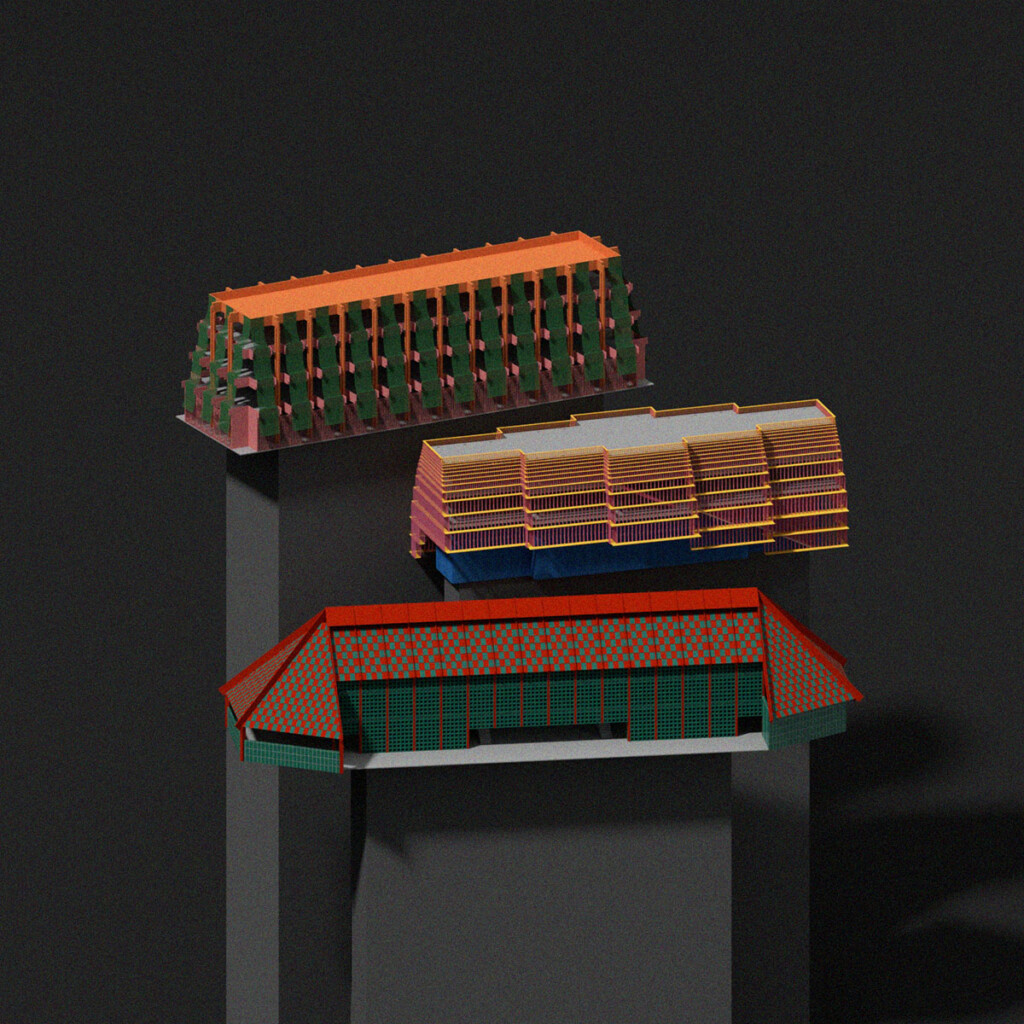
Deok Kyu Chung: James Templeton Kelley Prize, Masters in Architecture II
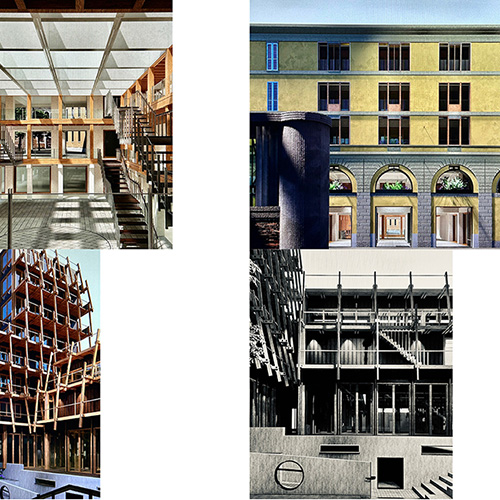
Saad Boujane: Master of Architecture in Urban Design Thesis Prize

Michael Zajakowski: Masters in Urban Planning Thesis Prize
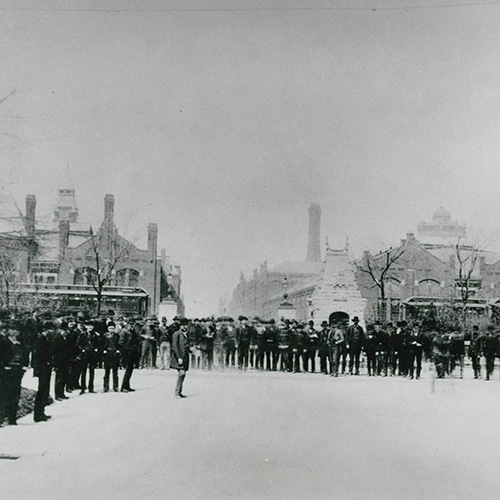
Sonia Sobrino Ralston: Masters in Landscape Architecture I AP Thesis Prize

Kevin Robishaw : Masters in Landscape Architecture I Thesis Prize

Celina Abba and Enrique Cavelier Masters in Landscape Architecture I AP Thesis Prize
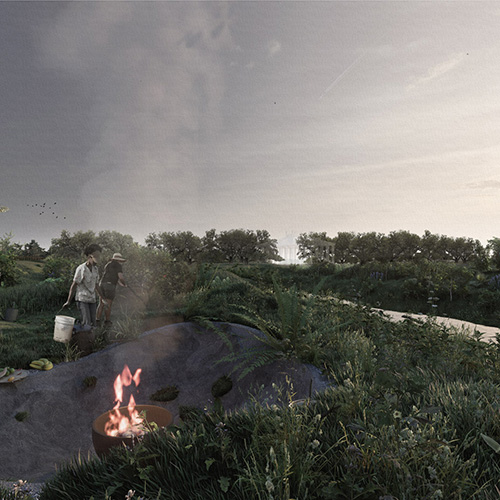
Alaa Suliman Eltayeb Hamid MDes Design Studies Thesis Prize
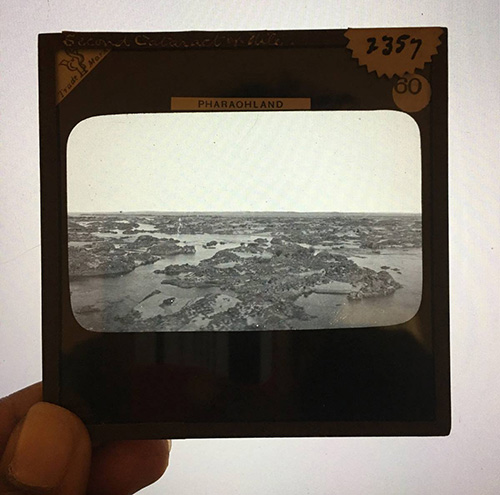
Rebecca Brand and Caroline Fong: Outstanding Design Engineering Project Award
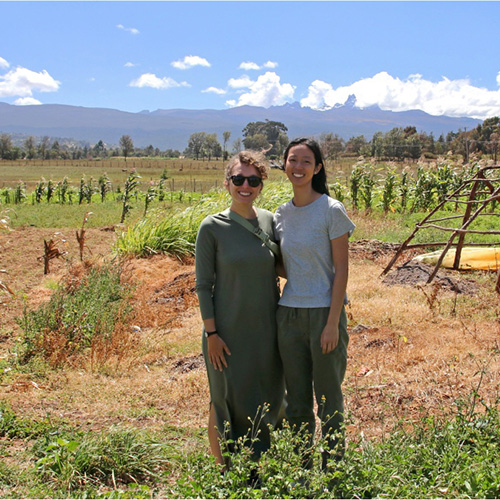
Meet the GSD Class of 2023 Commencement Marshals
Each year, graduating students from the Harvard Graduate School of Design come together to nominate and elect classmates to serve as commencement marshals by program. Being selected as a commencement marshal is one of Harvard’s most beloved traditions and is a high honor for a graduating student. During commencement exercises, marshals help to organize the GSD procession to Harvard Yard. After Commencement, the marshals become the alumni liaisons for their class cohorts.
Meet the graduates who will represent their program at the GSD’s 2023 Commencement:
Architecture: Sarah Pumphrey
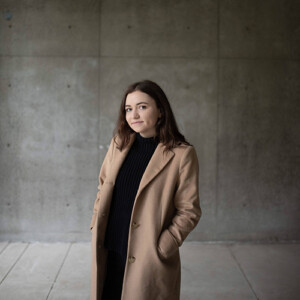
Sarah Pumphrey proclaimed her dream to be an architect in first grade. After exploring the fields of graphic design and sociology, she graduated with a BFA in Architectural Design from James Madison University near her hometown of Richmond, Virginia. At JMU, she earned the Thesis Prize, the J. Binford Walford Scholarship in Architecture, and was named Alan Tschudi Outstanding Student in Design. While at the GSD, Sarah engaged in student leadership, serving as Student Forum Academic Chair and Resources Chair, a Mentor with The Mentor Collective, and a Graduate Teaching Assistant. Sarah was an entrepreneur-in-residence at MITdesignX , and, alongside her co-founders, won third place of the top nine startups at MIT in 2021. She collaborated with CO-G Architecture and worked for MACHADO SILVETTI during her time at the GSD. This summer, Sarah will nurture her love for sharing knowledge, “works-in-progress”, and interdisciplinary learning by teaching in the GSD Design Discovery program.
Landscape Architecture: Matthew Gorab
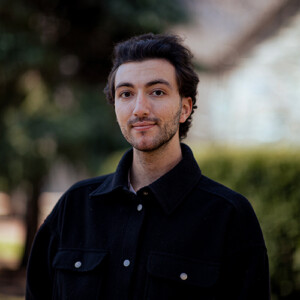
Originally from Franklin Lakes, New Jersey, Matt Gorab moved to Boston, Massachusetts, where he studied Architectural Studies at Boston University. At Harvard, Matt worked as a Research Assistant Teaching Assistant and served as an MLAI ’23 Class representative. During his time at the GSD, his interests in Landscape honed in on the healing capacities of Landscape and the harmonies infrastructure and Landscape can yield. As a recipient of the Penny White Project Fund, Matt completed field research for his project, Rest Stopping Across America: An Investigation of Northeast and Midwest Rest Stops. When he finds the time, Matt enjoys bookmaking, reading, or sitting under a Shagbark Hickory.
Urban Design: Haixin Yin
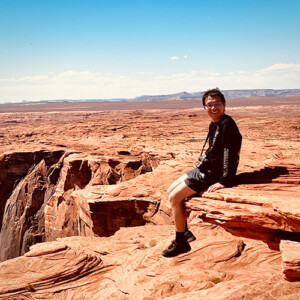
Haixin Yin was born and raised in an urban planner family in Kunming, China. He received his B.A. in Architecture with distinction from Tongji University, where he was appointed the college marshal with the highest honor of Outstanding Graduate of Shanghai. His professional interests lie at the intersection of urbanism, AI-aided design, and sustainable development. At GSD, Haixin explored how cities can use high-performance transportation infrastructure, such as high-speed rails, to cultivate centrality and efficiency, proposing sustainable travel methods in the urban realm. And his paper Speedy Facade: AI generation of 3D building façades from users’ verbal descriptions, which helped all stakeholders join the decision-making process with improved inclusiveness, was recently accepted by eCAADe 2023. Outside of class, Haixin volunteered at Sunshine House, co-creating artworks with individuals with different abilities and participating in public exhibitions. He enjoys running along the Charles, snowboarding, and traveling in his free time.
Urban Planning: Lindsey Mayer
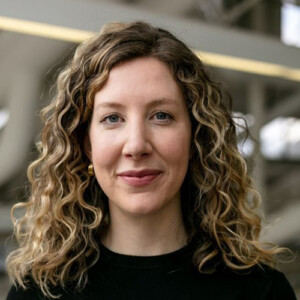
Lindsey Mayer grew up in the Rocky Mountains of Ogden, Utah and received her B.A. in Political Science at the University of Portland. Before coming to Harvard, Lindsey worked for the New York City Mayor’s Office under the Deputy Mayor for Housing and Economic Development , where she was inspired by the role that planning can play in making cities more equitable. She then went on to work at the NYC Economic Development Corporation where she co-founded the Design Corps, an initiative that paired architects with restaurants under the City’s outdoor dining program in response to Covid-19. During her time at the GSD, Lindsey discovered how planning is crucial in meeting our decarbonization goals and worked on several climate-oriented projects based in Buenos Aires, Argentina, where she plans to work after graduation. She is tremendously honored to represent the 2023 cohort of graduating MUPs and is already looking forward to her future class reunions.
Design Studies: Ibrahim Ibrahim
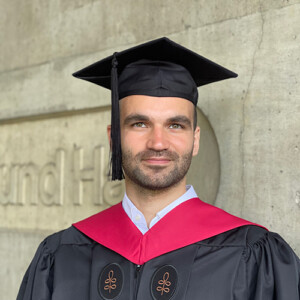
Ibrahim Ibrahim is a Lebanese design technologist working across disciplines and scales: from philosophy of technology to innovative technical workflows, to exploring collaborations between humans, machines, and artificial intelligence. He is currently a MDes (Mediums) candidate where he researches the creative applications of machine learning in design processes and tools. Prior to joining Harvard, Ibrahim practiced as an architect and computational designer in Los Angeles, Madrid, and Dubai. He holds a B.A. in Architecture from the American University of Sharjah, where he received the MAD Award, Dean’s Award for Academic Excellence, and the Sheikh Khalifa merit scholarship.
Design Engineering: Yoolim Jenn Kim
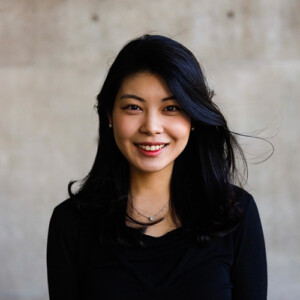
Yoolim Jenn Kim, originally from Seoul, had a formative cross-cultural upbringing in Korea and the US. She studied sociology and psychology at Wellesley College and researched at MIT’s Media Lab , where her passion for the convergence of social science, technology, and design flourished. She then worked as a consultant at Accenture, catering to clients across finance, hospitality, and healthcare. At Harvard, Jenn further expanded her horizons by exploring complex systemic problems, including designing a sepsis diagnostic kit, promoting food waste awareness, combating malnutrition in Mali, and preserving indigenous knowledge as cultural sovereignty. Her nonlinear and diverse journey embodies the multidisciplinary spirit of the MDE program and its students, whom she is constantly inspired by. Jenn also served as the MDE ’23 Class Representative for two years and Teaching Fellow at SEAS . In her leisure time, Jenn enjoys walking by the Charles, hot yoga, and exploring art museums. Jenn is honored to represent the remarkable 2023 cohort of MDE students.
Doctor of Design: Daniel Tish
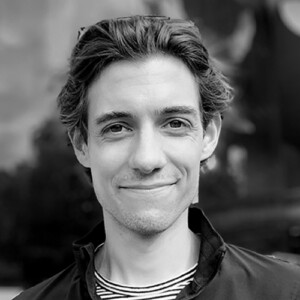
Daniel Tish is a designer and researcher whose work lies at the intersection of digital fabrication, material science, sustainability, and computation. Daniel’s dissertation research develops carbon-negative, 3D-printable building materials made from microalgae. His work treats the high carbon footprint of the built environment as an opportunity for design and configures circular economies and technological solutions to address this issue. The research establishes multidisciplinary collaborations with domain experts in material science and operates from both a top-down ecosystem and a bottom-up material perspective. Daniel is a member of the MaP+S group at the GSD, and the Harvard Center for Green Buildings and Cities and the Joint Center for Housing Studies of Harvard University have generously supported his research. Daniel is an Instructor in Architecture at the GSD and was previously a Lecturer at the University of Michigan. His work has been published in several journals and international conferences and recently exhibited at Design Miami/Basel .
GSD Faculty, Students, and Alumni Participate in Venice Architecture Biennale’s 18th Edition, “The Laboratory of the Future”
The Harvard Graduate School of Design community is well-represented in the 2023 Venice Architecture Biennale , which opened to the public Saturday, May 20. The event is among the most celebrated global forums for architecture. Curated by Lesley Lokko (Senior Loeb Scholar ’22) and organized by La Biennale di Venezia, the 18th International Architecture Exhibition, titled The Laboratory of the Future, examines what it means to be an “agent of change.” The exhibition includes 89 participants, over half of whom are from Africa or the African Diaspora with a 50/50 gender balance.
“In architecture particularly, the dominant voice has historically been a singular, exclusive voice, whose reach and power ignores huge swathes of humanity—financially, creatively, conceptually—as though we have been listening and speaking in one tongue only,” Lokko said in a curatorial statement. “The ‘story’ of architecture is therefore incomplete. Not wrong, but incomplete. It is in this context particularly that exhibitions matter.”
Members of the GSD community, including students, faculty, alumni, and Loeb Fellows are involved across the Biennale’s programming, with a GSD presence in the The Laboratory of the Future, several National Pavilions, and additional exhibitions, panels, and events throughout the city. Select GSD faculty, alumni, and Loeb Fellows, received awards for their contributions to the biennale:
Alessandro Petti (LF ’17), and architect Sandi Hilal of DAAR, received the Golden Lion Award for best participation in The Laboratory of the Future. The Beit Sahour, Palestine–based firm present façade, a critical examination of reappropriation, reuse, and “subversion of fascist colonial architecture and its modernist legacy.” DAAR actively develops research-based projects situated at the intersection of architecture, art, pedagogy, and politics.
The installation façade is an attempt to profane the rural settlement of Borgo Rizza (Syracuse, Sicily), built in 1940 by the Ente di Colonizzazione del Latifondo Siciliano, a fascist-era organization that aimed to reclaim, modernize, and repopulate Sicily, which the regime considered backward, underdeveloped, and “empty.” A similar architectural blueprint was adopted by fascist colonial urban planning in Libya, Somalia, Eritrea, and Ethiopia around the same time. The installation is a scaled reproduction of the village’s main building façade, which the artists deconstructed into fifteen multipurpose modules and transformed into seating and tables.
Joseph Henry (LF ’24), alongside Jayden Ali, Meneesha Kellay, and Sumitra Upham, curated the British Pavilion, which received a special mention for national participation. The exhibition Dancing Before the Moon explores non-extractive material culture, revealing how diasporic craft and material cultures can help foster a more sustainable future for British architecture, built on principles of care and equity over extraction and exploitation. The installation features new work, projected images, and a soundscape that promotes the banality of everyday routines as forms of spatial practice for diasporic communities and present new ways of thinking about architecture and the built environment.
Heinrich Wolff, Design Critic in Urban Planning and Design, and Ilze Wolff of Wolff Architects earned a special mention as a participant for Tectonic Shifts. Like a series of soil profiles, the exhibition comprises vertical bands; at the top are significant current drawings, films, or photos, and below these are the layers which are the precursors of this work. At the base of each vertical section are the collective subconscious and themes of the various people who collaborate as or with Wolff. The installation features a series of vertical scrolls that overlay screened content and photographs on cyanotype printed textile. These blueprints have a well-known reference to historic ways of reproducing architectural drawings, but as sun prints, they are reproductions that require only solar energy to be made. These prints are an expression of abundance at a time of South Africa’s current energy supply scarcity.
Tau Tavengwa (LF ’18), South African founder and co-editor of Cityscapes Magazine, was part of the 2023 International Jury of the 18th International Architecture Exhibition , selected by the Board of Directors of La Biennale di Venezia. The other jury members include Italian architect and curator Ippolito Pestellini Laparelli as president; Palestinian architect and curator, Nora Akawi; American director and curator of The Studio Museum in Harlem, Thelma Golden; and London-based Polish architect, researcher, and educator Izabela Wieczorek.
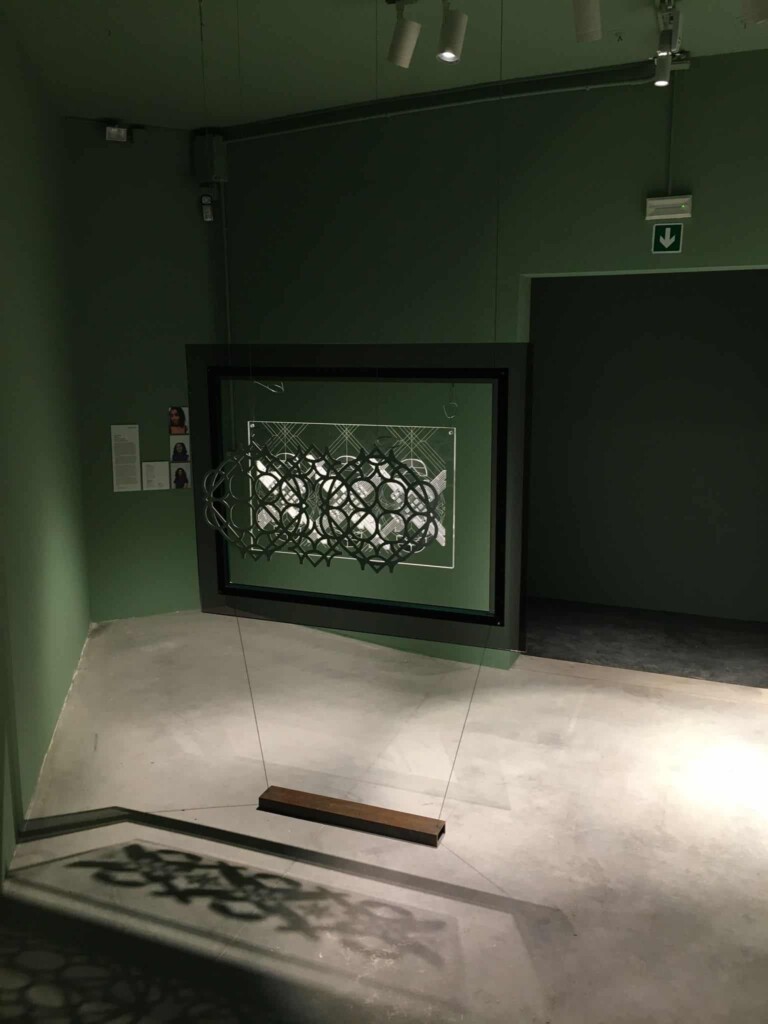
Rekha Auguste-Nelson (MArch ’18), Farnoosh Rafaie (MArch ’18), Isabel Strauss (MArch ’21), of Riff Studio present Guests from the Future: A Window (Detail) from the Future (Case Study House). The installation exemplifies the concerns of Riff Studio’s Case Study House: Chicago, which responds to the economic model for repair outlined in Isabel Strauss’s request for proposals for Architecture of Reparations. That project attempts to address the persecution of African Americans and Black peoples by imagining a site-specific future for acknowledgement, redress, and closure. The Case Study House: Chicago is “a design for this future,” according to the studio. Their display in Venice both integrates and alludes to the protective domestic programming of the Case Study House: Chicago, developed by Rekha August-Nelson. Using crystal glass manufacturing techniques and ‘ayeneh kari’ mirror mosaics, which Farnoosh Rafaei developed, the window installation refracts light and distorts form. Such windows could obfuscate individuals inside a residence so they cannot be targeted from the street.
Maryam Aljomairi (DDes ’25), with Latifa Alkhayat, curated an exhibition titled Sweating Assets at the Bahrain Pavilion. The pavilion explores the unique climatic conditions of extreme heat and humidity alongside current demands for comfort in Bahrain. The exhibition traverses scales—from the domestic to the territorial—highlighting the position of cooling infrastructure in relation to a wider ecosystem. Sweating Assets is an adaptive means of resource management, that entails working with existing systems to their best capacities rather than starting anew. It considers our built environments, infrastructure, and relationships as a complex, resource-rich, man-made landscape subject to cannibalization.
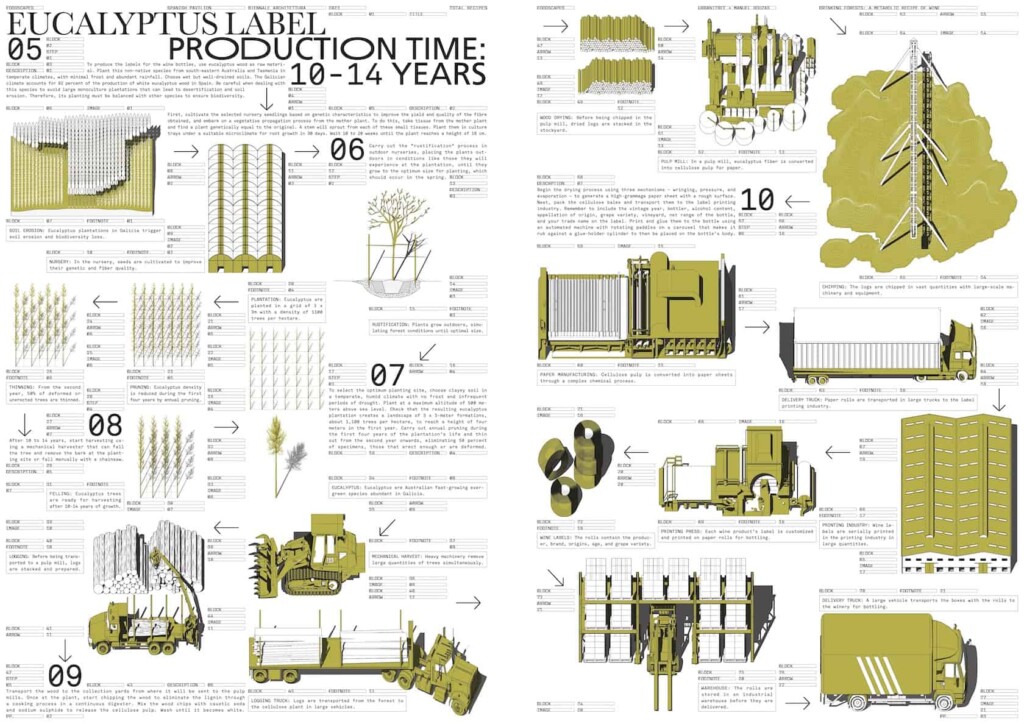
Manuel Bouzas Barcala (MDes Ecologies ’25) and Daniel Ibañez (MDes ’12, DDes ’21), have installed Drinking Forests: A Metabolic Recipe of Wine at the Spanish Pavilion. The pavilion theme, “Foodscapes” focuses on the architecture of food production, distribution, and consumption. The project explores the relationship between wine and forests and how the winemaking process generates a cultural and sensory journey that is linked to the regions where the wine is produced.
Ryan Bollam (MArch ’09) and DK Osseo-Asare (2023 Wheelwright Prize Finalist), from Low Design Office, present Enviromolecular. In collaboration with French design consultancy Panurban, the Agbogbloshie Makerspace Platform (AMP) initiative combines lab research and iterative ‘popular prototyping’ via community workshops with grassroots makers in West Africa to co-design flexible archi-technology for crafting space. The project was initially launched in 2012 as a transnational project to promote maker ecosystems in Africa by co-designing the reuse and recycling of materials with students and young professionals. “AMP amplifies circular processes of (re)making with others as a mode of collective habitation,” states Osseo-Asare. “The open-source design kit builds equity by replacing paradigms of innovation with reparative praxis of renovation for spatial justice across physical and digital realities.” Enviromolecular is located at the Dangerous Liaisons section of the Central Exhibition in the Arsenale complex.
Sean Canty (MArch ’14), Assistant Professor of Architecture, and his firm Sean Canty Studio, takes part in “Force Majeure,” one of the six sections of Lokko’s exhibition. His installation Edgar’s Sheds, which he calls a “retroactive reprojection’” is loosely based on two sheds constructed by Canty’s great-grandfather Edgar in Eliot, South Carolina. Steeped in aesthetics and Black vernacular, the installation is a half-scale mock-up, an architectural miniature that functions as both homage and a spatial counterpart to the original sheds. Each component of the installation is partial: a fragment that articulates the gaps in the knowledge of his relationship with his grandfather and with the original structures. “This approach draws attention to the holes and ruptures of our collective history of black experience, a direct consequence of slavery,” Canty writes in a statement. “A soundscape elaborates each structure’s interior life, mood, and vibe, filling the installation with complicated and contradictory scenes.”
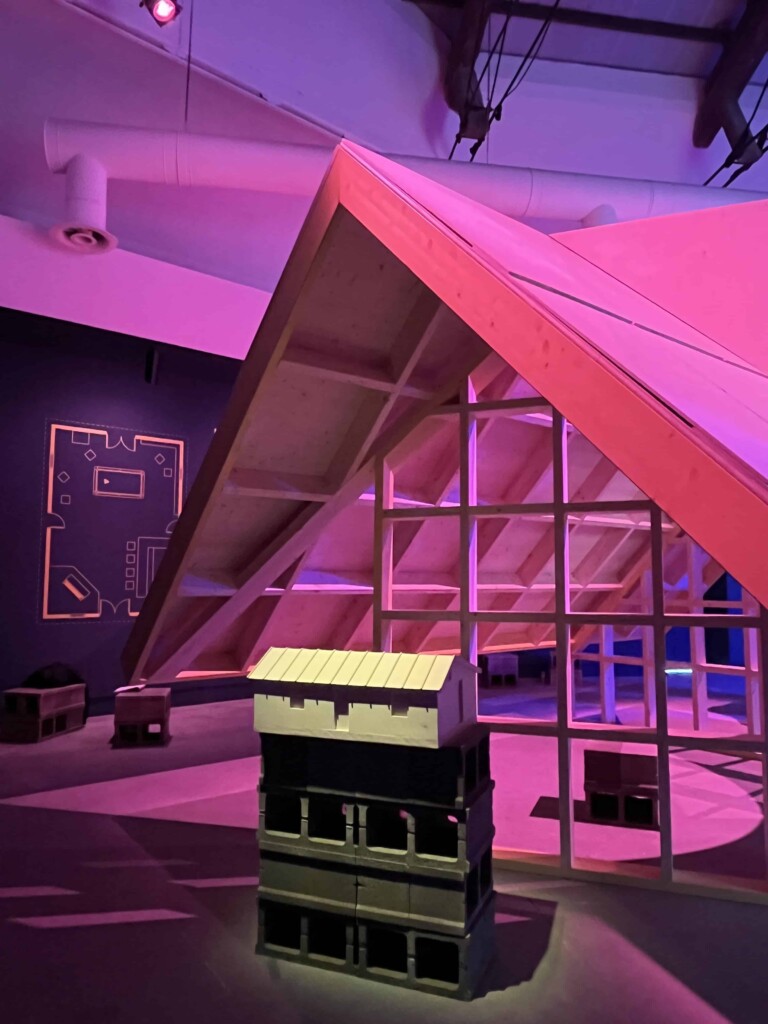
Ana María Durán Calisto, Design Critic in Urban Planning and Design, co-principal of the Ecuadorian-based Estudio A0, presents Surfacing—The Civilized Agroecological Forests of Amazonia. The project takes as its point of departure the Andean concept of a Minga, denoting co-producing and co-creation. In this spirit, Estudio A0 and Yale School of Architecture students worked in collaboration with Waorani artist-weavers Tiwino and Tepapare communes whose practice constitutes an “act of resistance against continuous encroachment of oil companies in Waorani territory.” The weavings and tapestries on view reflect on historically contested representations of land and civilization in the Amazon river basin. As the contributors note in a statement, new technologies designed to survey for raw materials have revealed ancient urban formations that were decimated by colonialism. The aim of the project, they write, is to understand these cities “not as exotic urbanisms to be marginally included in history textbooks, but as brilliant, working examples of urban ecology that may lead our way into a reconciliation of the city, its foods systems, and its hinterlands.”
Jeanne Gang (MArch ’93), Professor in Practice of Architecture, and Studio Gang, are featured in Reconceptualizing Urban Housing, a collateral exhibition on innovative housing design curated by Canadian architect Heather Dubbeldam. The exhibition brings together nine women-led practices from around the globe with unique perspectives on collective housing, primarily in or near urban areas. The diverse range of projects exhibited not only feature a variety of approaches from Europe and North America, but also from developing nations such as Uganda, Malaysia, and Mexico, exploring diversity in building typology, climate, and economic and cultural factors, while embodying a shared commitment to social and environmental sustainability. Reconceptualizing Urban Housing features Studio Gang’s City Hyde Park and One Delisle. The presentation is part of the larger Time Space Existence satellite exhibition, organized by the European Cultural Centre.
Toni Griffin, Professor in Practice of Urban Planning, present Land Narratives: Fantastic Futures, installed an exhibition in the Central Pavilion that explores the lost histories and potential futures of “Black Belt” sites on Chicago’s South Side. Griffin’s project draws from interviews with eight Chicagoans who relate their land memories as well as dreams of “fantastic futures” for their neighborhoods. She prompted her subjects, who include generations of Chicagoans ages 25 to 80, to think beyond worldly constraints, using the trope of the superhero to challenge them to think of future-forward scenarios for the places they call home. “The latent value of this land, occupied by Black Americans, can be unlocked by Black creative imaginations,” Griffin says. Through collage, mapping, video, audio, and 3D-printed clay vessels, the installation translates the subjects’ cultural practices, joys, and unbound visions.
Stephanie Hankey (LF ’22), Michael Uwemedimo (LF ’22), and Jordan Weber (LF ’22), present Synthetic Landscapes, an exhibition that examines the regenerative future for two sites in ecological decline. One is near the Niger Delta, where the Escravos estuary opens onto the Atlantic. A multi-billion-dollar gas-to-liquids complex owned by Chevron occupies a giant sandfill dredged from surrounding creeks, while the nearby villages are vanishing into the ocean. Satellite imagery shows a dendritic tangle of creeks cut through by engineered geometries of oil extraction: pipeline trenches, wellhead pits, flare towers, and the trussed lines of tanker jetties. Oil spills can be seen from space. The second site examined in Synthetic Landscapes is on the other side of the Atlantic. The flat of the Midwest’s industrial cropland is a pixelated plane of intensive agri-production, broken only by the turbulent swirls of deep green cyanobacteria massing in waterways fed by fertilizer runoff. Decades of mono-cropping and plot conglomeration have stripped soil nutrition, and aggressive agriculture practices have resulted in generations of racialized land inequity. From microbial fuel cells which digest hydrocarbons to community concerts staged on replanted spill sites or rewilded croplands, Synthetic Landscapes investigates land use in a way that not only questions who land belong to, but also how we belong to the land in such sites of struggle and celebrations.
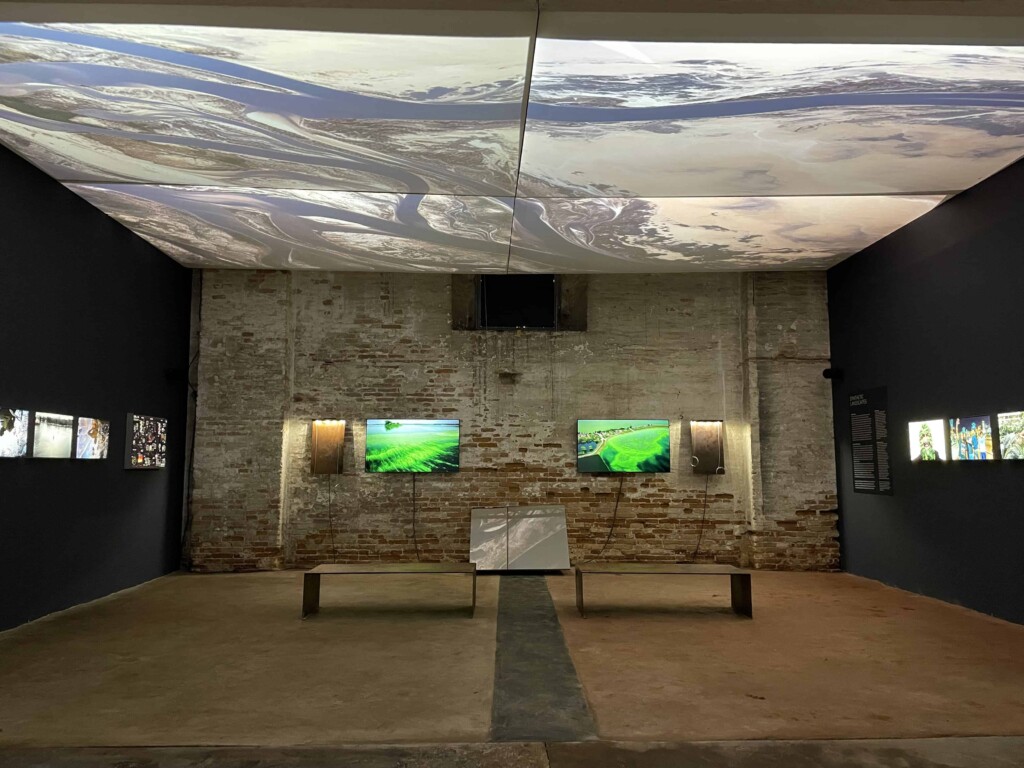
Eric Howëler, Associate Professor in Architecture, alongside Mabel O. Wilson and J. Meejin Yoon (MAUD ’97), participate in the Curator’s Special Projects Mnemonic, curated by Lesley Lokko, and one of the six sections of the exhibition. The immersive installation unknown, unknown constructs a space of light and sound to remember the unnamed and named members of the enslaved community at the University of Virginia (UVA) in Charlottesville, Virginia.Through a cache of historic photographs, architectural drawings, and research material, the installation explores the archival absence and erasure of approximately 4,000 unknown and known community members who built, worked, and maintained the university from 1817 to 1865. The two-sided multi-channel video and audio projection is captured on suspended sheets of muslin, a cotton fabric that recalls the domestic labor by Black women at UVA and the spaces where they lived and worked. By forming a counter archive of imagery and sounds, “unknown, unknown” re-humanizes this community by rendering their unknowability into moments of refuge and spaces of liberation.
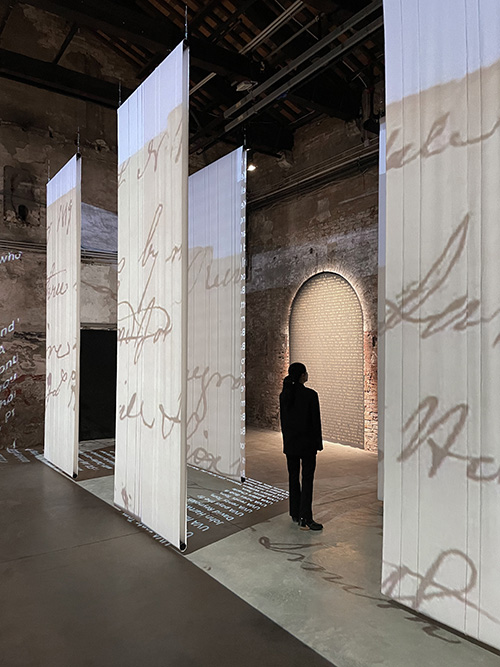
Nahyun Hwang (MArch ’01) David Eugin Moon (MArch ’01), of N H D M Architects, present Migrating Futures, an ongoing project that investigates the historical and contemporary geographies of diverse diaspora communities and transnational migrant workers within Korea and across Asia. While subjected to the enduring colonial legacy of subjugated and racialized laboring bodies and extremely precarious work and living conditions, the ostensibly transient global subjects shape and embody emergent and hyper-local spatial typologies, new socialities, and potently intersectional cultural and agentive capacities. Intimately engaging the specifics of selected peri-urban and rural migrant enclaves, the exhibit speculates on the possibilities of future communities shaped by the new frameworks of labor and belonging. Interrogating the global landscapes of capital-driven migrancy, the project challenges the existing notions of work, identity, and ownership, in the context of collective crises, of climate change and other dissolution of environmental and sociopolitical givens.
Held at the Central Pavilion on May 20, Hanif Kara, Professor in Practice of Architectural Technology, and Mpho Matsipa, Lecturer in Architecture, participated in the panel “How to architect alternative futures and beyond…?” The panel gathered practitioners and theorists from within the architectural field alongside those from the next generation of architects to question the roles of research, narration, design, planning, and space-making in the context of a fragile world. How can spatial practices contribute to visionary–while at the same time, tangible–ecological, technological, and decolonized futures, from the very local to the planetary, beyond human-centered interests? Hanif Kara acted as lead engineer for the award-winning British Pavilion exhibition Dancing Before the Moon. He was also part of the engineering team supporting the Sean Canty Studio installation Edgar’s Sheds.
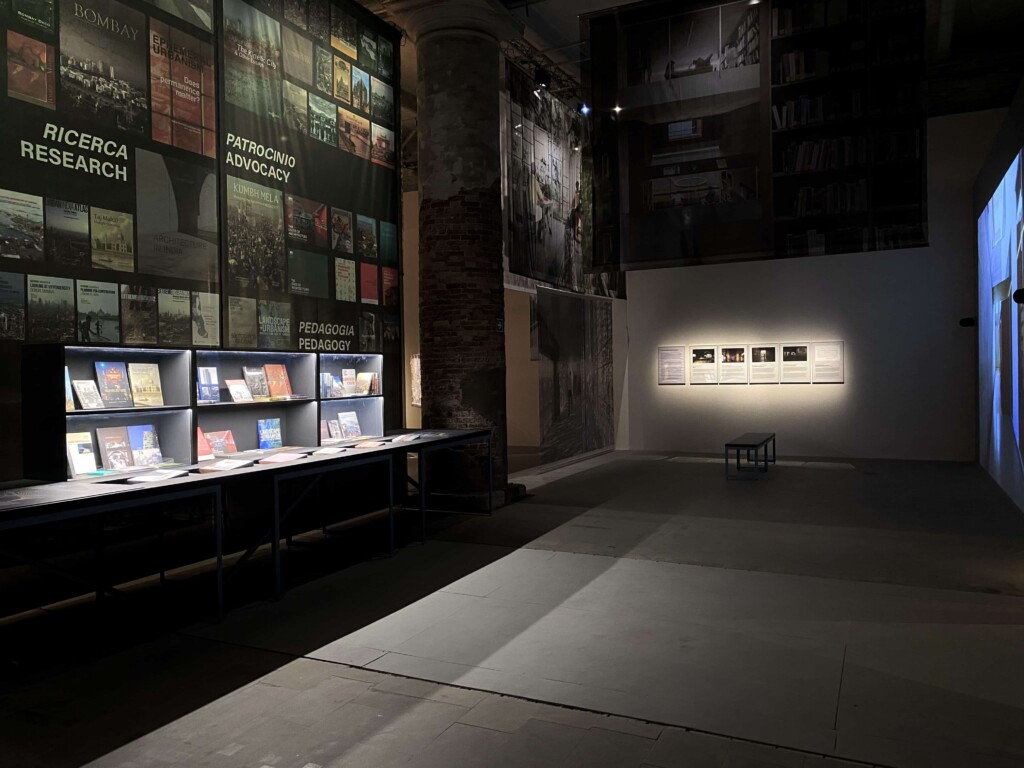
Rahul Mehrotra, Chair of the Department of Urban Planning and Design and John T. Dunlop Professor in Housing and Urbanization, has presented projects at four previous editions of Venice Biennale, in 2006, 2016, 2018, and 2021. This year, Mehrotra with Ranjit Hoskote contribute Loops of Practice, Thresholds of Habitability, on display at the Arsenale. The ambition of the installation is to highlight the importance of simultaneously designing, practicing, thinking, and exploring through various modes and methods. The exhibition engages with some key themes in Rahul’s work, offering a model of how an architect’s practice can straddle commitments to built form, to research, to conservation, to pedagogy, to activism, and advocacy aimed at changing policy. To emphasize temporality and waste reduction, material is reused from Mehrotra’s previous biennale.
Lyndon Neri, Design Critic in Architecture, and Rossana Hu, Visiting Professor in Architecture, are founding partners of Neri&Hu Design and Research Office. The installation Liminality is part of the “Dangerous Liaisons,” one of the six sections of the exhibition at the Arsenale. The installation examines post-colonial thinking and its relationship to the idea of liminal spaces, or third spaces. Liminality is presented as a kind of threshold, a stage for transitory and frontier events that give rise to new possibilities, instigate change and, more importantly, challenge the status quo. Through models, drawings, and film, Neri & Hu cast liminality as a zone between design practice and theoretical exploration by revisiting three adaptive reuse projects highlighting the studio’s research.
Student work from the Spring 2023 MDes Open Project Apparatus for Hacking Perception, is part of the satellite exhibition Time Space Existence . The show features completed and ongoing projects, innovative proposals, and utopian dreams of architectural expressions. Apparatus for Hacking Perception experiments with new techniques and technologies for visual and spatial storytelling, environmental issues, spatial interactivity, and cognitive science. Of particular importance are practices that seek to engage with the public and social realm, using advanced technological support for forms of expression that can be both projective and mnemonic. The participating MDes ’23 students are Muqing Bai, Zoe Chen, Qing Feng, Amelia Gan, Kenny Kim,Vishal V, Joseph Wu, Nuknik Lam, Nix Liu Xin, Sarah Nicita, Xinyi Yang, and Hyejun Youn. Allen Sayegh, Design Critic and Senior Interaction Technologies Fellow, led the course. He is also Head of the MDes program Mediums, one of four concentrations within the program that aims to advance innovative methods for making and understanding form and technologically driven design.
Elisa Silva, Lecturer in Architecture, participates in the exhibition Inhabit, part of the Swiss Pavilion, curated by Philip Ursprung and Karin Sander. Neighbours, the pavilion theme is focused on the spatial and structural proximity between the Swiss Pavilion and its Venezuelan neighbor. By turning architecture itself into the exhibit, the project also highlights the bond between the architects of the two structures: the Swiss Bruno Giacometti (1907–2012) and the Italian Carlo Scarpa (1906–1978). On Saturday, May 20, Silva, a native Venezuelan, joined a conversation with representatives of three of the world’s leading architecture collections, including Giovanna Borasi, Director of the Canadian Center for Architecture, Montreal; Andres Lepik (LF ’12), Director of the Architecture Museum, Technische Universität, Munich; and Martino Stierli, Philip Johnson Chief Curator in Architecture and Design, the Museum of Modern Art, New York.
Zhang Ke (MArch ’98) of ZAO/standardarchitecture presents Co-Living Courtyard, an installation conceived as a co-living workshop staged beneath a suspended mock-up of the Hangzhou Museum. Communities throughout history have practiced communal living and resource sharing as a way of life. From the Indigenous to the modern urban community, societies have incubated new social systems, facilitated cultural exchanges, and developed co-living ideas in shared spaces. The exhibition incites visitors to dwell in its courtyard, as the philosophers did in ancient Chinese gardens, and ponder the vital relationships between interior and exterior, architecture and landscape, memory, and identity, envisioning new aspects of co-living and inducing discussions on sustainable co-living.
Sara Zewde, Assistant Professor in Practice of Landscape Architecture, will participate in the panel, “Inconvenient Truths” on November 21, 2023, at the Arsenale. The panel is a capstone of Carnival , a six-month program of public events that invites professionals from other disciplines and sectors to share the stage with architects, academics, and students. The curated panel discussions attempt to bridge the gulf between architects and the public.
Interview with Toni Griffin: A Spotlight on the MDes Degree Publics Domain
How is a public constituted, both spatially and socially? How does the public become legible and desirable? For whom does it exist? These are some of the questions that animate Toni Griffin’s proseminar “Of the Public. In the Public. By the Public” at the Harvard Graduate School of Design (GSD). Toni Griffin, Professor in Practice of Urban Planning at Harvard GSD, specializes in leading complex, transdisciplinary planning, and urban design projects for multi-sector clients in cities with long histories of spatial and social injustice. The proseminar course draws from scholars, practitioners, and urban planners to build foundational intelligence and provocative interpretations of the plural meanings of public.

Griffin is Domain Head for Publics, one of four concentrations in the Master in Design Studies (MDes) at GSD. The program challenges conventional ways of learning and prepares students to understand how design shapes and influences the underlying processes of contemporary life. The program is uniquely situated at the GSD to draw on insights from a multitude of fields and expertise to break down the silos between disciplines and develop a holistic understanding of complex issues. Through fieldwork, fabrication, collaboration, and dissemination, the program is aimed at those who want to develop expertise in design practice while gaining tools to enable a wide range of career paths. Students select one of four domains of study—Ecologies, Narratives, Publics, and Mediums—and undertake a core set of courses, including labs, seminars, workshops, initiatives, publications, and ongoing projects that connect advanced research methods and related topical courses. Uniquely, trajectories within each domain allow students to construct their own interdisciplinary tracks and take part in course offerings across the GSD, as well as other schools and departments at Harvard.
Many of these core concepts resonate with Grffin’s practice. She is founder of urbanAC , based in New York, and leads the Just City Lab , a research platform for developing values-based planning methodologies and tools, including the Just City Index and a framework of indicators and metrics for evaluating public life and urban justice in public plazas.
Harvard GSD’s Joshua Machat spoke with Toni Griffin about the MDes program, open projects, and how the Publics domain set out to explore the socio-spatial design, planning, implementation, and advocacy.
Joshua Machat: Why do you think the Publics domain is of interest to architects who are still in the early parts of their professional careers?
Toni Griffin: They appear to be architects who are no longer satisfied with traditional modes of architecture, which tend to focus on the building and the outcome. They’re more interested in the forces that shape architecture and the built environment. And they’re interested in the impact of that architecture on society, people, and place. Architecture, particularly in its pedagogy in undergraduate and graduate programs—and sometimes even in practice—doesn’t address those issues sufficiently. I’m finding that applicants are looking to round out their understanding of how the built world is produced through architecture and/or other disciplines. Who is involved in that work, who’s impacted in that work, who does that work benefit, and who gets to decide, are all part of their curiosities.
Interdisciplinary and transdisciplinary thinking is a critical part of contemporary problem-solving in design. Can you explain how this approach is integrated into the Publics domain?
I do it perhaps in a couple of ways in the proseminar, which is divided into six modules. “To be Public”, which is about how we bring our individual identities, cultures, and backgrounds into the public realm. “Of the Public”, which is about the data, knowledge, memories, that we place into the public realm. “By the Public”, which is about public governance. “For the Public”, which is about the things that the public sector provides for society, cities, and neighborhoods. “With the Public” is about engagement, participation, and power. “In the Public” is about how creatives and designers place things in the public realm.
We have two guest speakers who come and speak on each of those modules. They tend to come from two disciplinary perspectives: two different disciplines are in dialogue about a particular topic every other week. Secondly, the students are put into teams, and they have to co-facilitate a class where they lead the discussion, not me. This requires them to work together. Because the students come from different backgrounds and experiences—whether different genders, ethnicities, nationalities, or disciplines—they often forge a cross-identity and cross-disciplinary collaboration.
The advance of the just city is at the core of your Publics proseminar. The Mayors Imagining the Just City Symposium was held in April and MICD Fellows discussed strategies for using planning and design interventions to address racial injustice in each of their respective cities. How did this conversation support the Publics proseminar learning objectives?
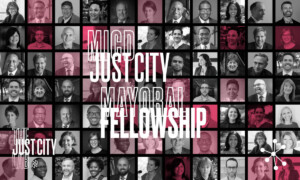
The Mayors Imagining the Just City public event is a part of the Mayor’s Institute on City Design (MICD) Just City Mayoral Fellowship program, which I lead through the Just City Lab. This is the third year of the fellowship in which eight mayors participate in an eleven-week online curriculum centered on best practices and examples of how urban planning, design, and development—the work that mayors lead—can achieve greater social and spatial justice.
During the closing session, when the mayors come back to Cambridge to present their projects and get feedback from eight resource experts, we end the program with a public program and presentation to give the GSD community exposure and access to city leaders and the roles that they play in building cities in collaboration with practitioners of the disciplines we offer at the GSD.
The learning objective is to create greater understanding around how public government, and specifically mayors, lead and shape this type of work. The event exposes students and the rest of the GSD community to the complexity of decision making around resources, choices, policies, and priorities that are helping to address issues in chronically disinvested neighborhoods and/or populations that have historically been marginalized through racially exclusionary and discriminatory practices.
It’s always my interest to expose students to other modes of practice, like the public sector, and the ways in which architects, landscape architects, and urban planners might find themselves situated in a public sector role—even running for mayor—and the ways in which their expertise can be useful within government, and not always as a consultant to government.
What do you think are the most distinguishing qualities of the MDes degree program at the GSD?
What makes the MDes program so attractive to students, and to me, is that it’s the most entrepreneurial design degree that we offer. Being a part of the program requires students to be comfortable with self-directing their journey through the four semesters. Students’ ability to choose a substantial number of your courses, across the departments at the GSD, across Harvard, and even some at MIT, is just amazing. It parallels how you might do a doctorate. It’s very self-directed. The beauty is in all the choices you get to make to inform your own intellectual curiosity. The challenge of that is all the courses on offer that you just won’t have time to do. It’s an embarrassment of riches and an extraordinary luxury students have that sometimes causes them a little bit of angst. But ultimately, they end up quite satisfied with the volume of choices.
I also like that the program includes students who have been out in the world working for some time alongside some students who are just coming out of their undergrad. I think that world experience, whether it’s two years or fourteen years, adds a lot to the depth of conversation. Students don’t realize that we as teachers are just as engaged in what they bring to the discussion as we give to them; in fact, it is a reciprocal relationship that makes for the best classroom environment.
The GSD is one of the most student-engaged design programs that I’ve ever been a part of. Students are very proactive through clubs, volunteer efforts, the production of their own events, and discussion groups. That brings a unique energy to the school and can drive change within the school. Students have a level of agency that allows them to feel very connected to each other and the GSD community, both during their time in the program and even after as alumni.
Harvard GSD Shortlists Four Architects for 2023 Wheelwright Prize
Harvard Graduate School of Design (GSD) is pleased to announce four shortlisted architects for the 2023 Wheelwright Prize. The Wheelwright Prize is an international competition for early-career architects. Winners receive a $100,000 (USD) fellowship to foster intensive, innovative architectural research that is informed by cross-cultural engagement and can make a significant impact on architectural discourse. Winning research proposal topics in recent years have included the potential of seaweed, shellfish, and the intertidal zone to advance architectural knowledge and material futures; how spaces have been transformed through the material contributions of the African Diaspora; and new architecture paradigms for storing data that can reimagine digital infrastructure.
The 2023 Wheelwright Prize drew a wide pool of international applicants. A first-phase jury deliberated in April; a winner will be announced in June.
Jurors for the 2023 prize include: Noura Al Sayeh, Head of Architectural Affairs for the Bahrain Authority for Culture and Antiquities; Mira Henry, design faculty at Southern California Institute for Architecture; Mark Lee, Chair of the Department of Architecture and Professor of Practice at Harvard GSD; Jacob Riedel, Assistant Professor in Practice of Architecture at Harvard GSD; Enrique Walker, Design Critic in Architecture at Harvard GSD; and Sarah M. Whiting, Dean and Josep Lluís Sert Professor of Architecture at Harvard GSD.
The four finalists for the 2023 Wheelwright Prize, and their proposals, are:
Isabel Abascal: “Mother Architecture: Shaping Birth”
Isabel Abascal is a Mexico City–based architect and writer. In 2015, she founded the architecture studio LANZA Atelier, along with Alessandro Arienzo. From 2015 to 2017, Abascal was the Executive Director of LIGA, Espacio para Arquitectura, a platform dedicated to the dissemination and discussion of Latin American architecture. There, she curated myriad exhibitions, and co-edited the book Exposed Architecture, published by Park Books. She has also contributed to publications such as DOMUS, Avery Review,Arquine, Wallpaper*, and the UNAM Journal, among others. Abascal studied architecture at the Universidad Politécnica de Madrid, the Technische Universität in Berlin, and at the Vastu Shilpa Foundation in Ahmedabad, under Balkrishna Doshi.
The World Health Organization estimates that almost 800 women died from preventable causes related to pregnancy and childbirth every day in 2020. Almost 95% of these deaths occurred in low and lower middle-income countries, and most could have been prevented. The high number of maternal deaths in some areas of the world reflects inequalities in access to quality health services and highlights the gap between rich and poor. With “Mother Architecture: Shaping Birth,” Abascal examines how rethinking architecture and spatial design can impact maternal mortality through case studies of matriarchal societies, home waterbirths, Pritzker-Prize maternity centers, and floating hospitals.
The Wheelwright Prize would expand research through case studies from the Americas and Europe to Western Africa and Southeast Asia, including Bolivia, Costa Rica, Mexico, Bangladesh, Senegal, and the United Kingdom. The research will inform the design of a space model for birth that could be implemented in both rural and urban areas by international health organizations and NGOs. The fieldwork, data collection, and prototype development, among additional research, will be disseminated amongst health practitioners and planning authorities, specifically for the places where the research was conducted.
Maya Bird-Murphy: “Examining Architectural Practice Through Alternative Methodology and Pedagogy”
Maya Bird-Murphy is a designer, educator, and the founder of Mobile Makers, an award-winning non-profit organization bringing design and skill-building workshops to underrepresented communities. She was selected by Theaster Gates and the Prada Group as an Experimental Design Lab awardee, featured as one of 50 people who shape Chicago in Newcity Magazine, and received the 2022 Pierre Keller Prize at the Hublot Design Prize ceremony in London. In 2018, she was named as an AIGA Design + Diversity Conference National Fellow. The same year, she was featured in The American Institute of Architects’ (AIA) Emerging Professionals Exhibition 2018 for Mobile Makers. Bird-Murphy attended Ball State University and received an M.Arch from Boston Architectural College.
Through her research and practice, Maya Bird-Murphy, investigates the connection between architecture and identity. She cites that the mounting challenges the architecture field faces, including the climate crisis, social inequality, and land equity, can no longer be ignored. With “Examining Architectural Practice Through Alternative Methodology and Pedagogy,” Bird-Murphy aims to investigate the friction that exists between the traditional and alternative design practices, to document the nuances of individual practices, and ultimately, to gather and share knowledge through architectural storytelling. The research proposal takes a critical look at how to accelerate systems change in the architecture field, and what United States–based firms can learn from alternative practices around the world, specifically by exploring innovative methods to collect, store, and share open-source knowledge and stories that foster authentic connection and dialogue in the field.
With the Wheelwright Prize, Maya-Murphy plans travel to eight international cities to research and gather stories and data, visit firms and project sites, and conduct interviews with alternative practitioners, including Material Cultures in London, Fernanda Canales Arquitectura in Mexico City, Atelier Masomi in Niamey, and Estudio Guto Requena in Sao Paolo. The research will result in a published anthology that features stories, interviews, and original works of art and design that amplify alternative practice models and methodologies. A collection of portraits will be housed on a project website for individuals who want to establish an alternative practice of their own, designers looking to work for a firm doing more meaningful work, or clients looking for mission-driven firms to work with. She will also schedule in-person curated experiences in select cities, including dinner salons, roundtables, panel discussions, and other related events.
Jingru (Cyan) Cheng: “Tracing Sand: Phantom Territories, Bodies Adrift”
Jingru (Cyan) Cheng works across architecture, anthropology, and filmmaking. Her practice follows drifting bodies—from rural migrant workers to forms of water—to draw out latent relations across scales, confronting intensified social injustice and ecological crisis. Cheng received commendations from the Royal Institute of British Architects (RIBA) President’s Awards for Research in 2018 and 2020. She is also a 2022 Graham Foundation Grantee. Her work has been exhibited internationally, as part of Critical Zones: Observatories for Earthly Politics at ZKM Karlsruhe, Germany (2020-22), Seoul Biennale of Architecture and Urbanism (2019), Venice Architecture Biennale (2018), among others, and included in the Architectural Association’s permanent collection. Cheng holds a PhD by Design and M.Phil in Architecture and Urban Design (Projective Cities) from the Architectural Association (AA), and was the co-director of AA Wuhan Visiting School (2015–17). She co-led the MA architectural design studio Politics of the Atmosphere (2019–22) and currently teaches an interdisciplinary module across all schools at the Royal College of Art in London.
From airports to beaches and river basins to hydroelectric dams, sand has an unnoticed yet significant impact on the built environment and human communities. Sand is a key component of concrete, glass, asphalt road, and artificial land, supporting modern cities and modern life. The act of dredging from underwater systems and channels, sand mining erodes riverbanks and disrupts ecosystems, resulting in a long chain of consequences and dependencies. Colossal amounts of sand are mined and moved to shape one habitat while destroying another. With “Tracing Sand: Phantom Territories, Bodies Adrift,” Cheng dissects iconic sand sites that give form to spatio-cultural territories that have been fueled by colonial globalization and high consumption. Her proposal aims to establish a reflexive framework for architecture towards a paradigm shift in the value system: what does it mean to build today amid ecological crisis and social injustice?
The Wheelwright Prize will support travel to airports in Singapore, beaches in Florida, rivers in the Mekong Delta in Vietnam, and rural immigrant communities in China. Cheng will conduct interviews with key stakeholders and research design decisions, procurement routes, contractual relations, financing, regulations, and policies. Combining her research across architecture, anthropology, and filmmaking, Cheng plans to develop educational and public programs and a multi-media archive that will be open access and made available for the affected communities, activist groups, and associated researchers.
DK Osseo-Asare: “Bucky in Africa: Remembering the Chemistry of Architecture”
DK Osseo-Asare is a Ghanaian American designer who makes buildings, landscapes, communities, objects, and digital tools. He is a co-founding principal of the transatlantic architecture and integrated design studio Low Design Office (LowDo), based in Austin, United States, and Tema, Ghana. He holds an appointment in Humanitarian Materials at the Pennsylvania State University, where he directs the Humanitarian Materials Lab, a transdisciplinary research lab architecting materials for human welfare. He is a TED Global Fellow; member, Ghana Institution of Engineering (GhIE); and received A.B. in Engineering Design and M.Arch degrees from Harvard University, with a focus on kinetic architecture and network power.
With “Bucky in Africa: Remembering the Chemistry of Architecture,” Osseo-Asare seeks to decolonize the practice of architecture using a mixed methods approach of action research to investigate the African roots of “design science” from an architectural perspective. The proposal’s focus starts with the decade-long itinerary of the American design scientist R. Buckminster Fuller’s transdisciplinary teaching and research in Africa. By studying the links between indigenous African technologies of design and established conventions of architectural production, Osseo-Asares incorporates linguistics, archival research, fieldwork, and community-based making with academic and community partners across Africa, the Middle East and Europe. The collected research constitutes a sequence of temporary outputs that will also contribute to the development of the next generation of African architects and designers, considered in the context of the global African diaspora.
Osseo-Asare’s Wheelwright proposal research stems from his finalist proposal for the 2019 MoMA PS1 Young Architects Program, “Bambot: Fufuzela,” which reconceived architecture as living structure with independent agency, understood from an African perspective, in which all material is alive and “spiritually active.” The Wheelwright Prize will support Osseo-Asare’s fieldwork throughout North Africa and Middle East, East Africa, West, Central and Southern Africa, and result in a publication, public lectures, and exhibition content as well as a series of workshops in various African communities.
Sean Canty Receives Architectural League of New York’s 2023 Prize for Young Architects + Designers
The Architectural League of New York (ALNY) has awarded Sean Canty (MArch ’14), Assistant Professor of Architecture at Harvard GSD, with the Prize for Young Architects + Designers , a competition open to architects and designers less than ten years out of a bachelor’s or master’s degree program. The 2023 Prize applicants were asked to consider the theme of “Uncomfortable,” engaging architects to consider the distressing aspects of the contemporary design world by “dismantling architectural legacies, challenging traditional paradigms, grappling with the costs of comfort, responding to ecological concerns.”
Sean Canty is the founder of Studio Sean Canty (SSC), an architecture practice based in Cambridge, MA. The work of the studio engages formal combination and juxtaposition at a variety of scales, from objects to interiors, and explores a range of programmatic types, from domestic environments to cultural spaces. Canty is also one of the founding principals of Office III (OIII), an experimental architectural collective that spans New York, San Francisco, and Cambridge.
The jury for the 2023 Prize for Young Architects + Designers, now in its 42nd cycle, includes José Amozurrutia, Germane Barnes, Jennifer Bonner, Barbara Bestor, FAIA, Wonne Ickx, Int. Assoc. AIA, Kyle Miller, Tya Winn, and the Young Architects + Designers Committee.
Winners will create installations of their work onsite in a location of their choice or in an entirely digital format. Projects will be presented in an online exhibition on the ALNY website opening June 13.
In March, Canty was among the recipients of the American Academy of Arts and Letters 2023 Architecture Award , for work being characterized by a strong personal direction. This year’s winners were chosen from a group of 36 individuals and practices nominated by the members of the Academy. The jurors were Toshiko Mori (chair), Deborah Berke, Marlon Blackwell, Steven Holl, Annabelle Selldorf, Nader Tehrani, Billie Tsien, Tod Williams, and Meejin Yoon.
Ryan Gerald Nelson on Designing Iconic Typographic Moments
Within the work of graphic designer Ryan Gerald Nelson there is a persistent thread of experimentation. He experiments with images, typography, materials, and printing techniques, often manipulating all these elements at once. The compelling results range from the elegant and spare exhibition catalogue for Merce Cunningham CO:MM:ON TI:ME to the aggressive, overloaded posters he created for the Walker Art Center and Yale University. The attention to both big ideas and small details made his Studio Xee a perfect fit for designing the posters and related materials for the Fall 2022–Spring 2023 public programs at the Harvard Graduate School of Design (GSD). As we look back on the academic year, Chad Kloepfer, art director of the GSD, caught up with Ryan. The two met years ago when Ryan was a design fellow at the Walker.
Chad Kloepfer: We began discussing the past year’s public programs identity on a conceptual level, looking at how the project’s intellectual foundations could inform the design. Paige Johnston, associate director of public programs at the GSD, brought up The Undercommons: Fugitive Planning and Black Study (2013), a collection of essays by Fred Moten and Stefano Harney that draw on a radical Black intellectual tradition to critique academia. Moten and Harney write about ways to create the worlds you want to inhabit, outside of or adjacent to the existing world and its systems of knowledge. These are not easy concepts to formalize into a poster, but I wonder how, or if, Moten and Harney’s text ultimately fed into the final design?
Ryan Gerald Nelson: I did have some early moments of feeling a bit lost in all the potential ways and paths of interpreting The Undercommons and trying to land on certain ideas that I felt could propel my design decisions within the poster.
But as I dove deeper into the text I couldn’t help but notice the extent to which Moten and Harney’s observations and discourse feel so relevant to so many different spaces and aspects of society. A public programs and lecture series at a major university certainly felt to me like one of those spaces.
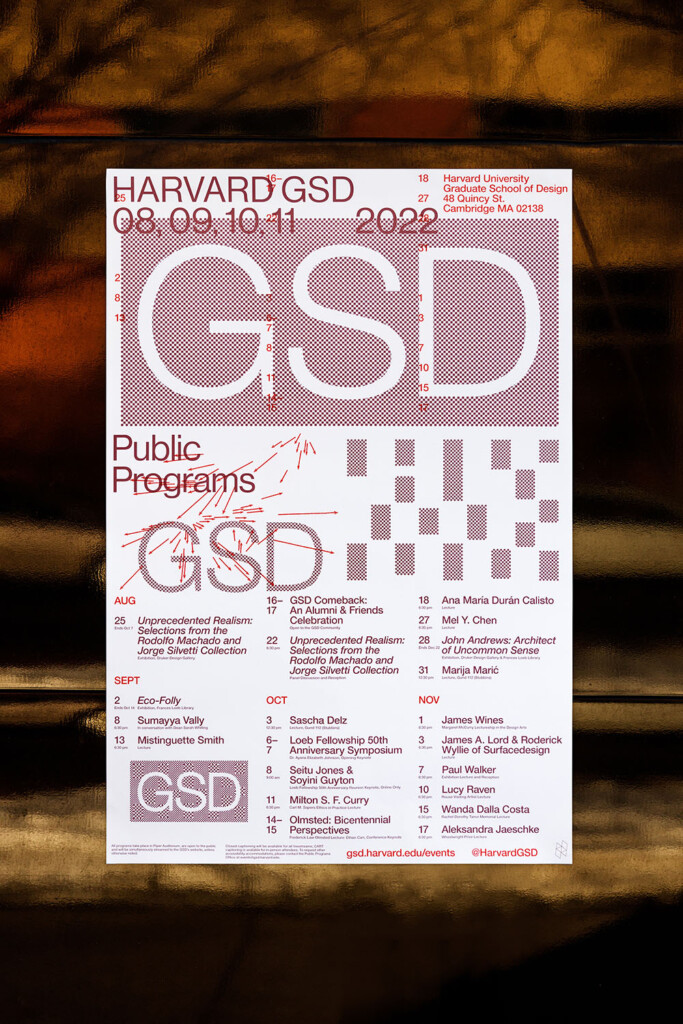
Ultimately, I felt like there was so much to glean from The Undercommons, and certain ideas from the book led me down a path that I wouldn’t have otherwise taken. As a graphic designer, that is something I always hope for in a project—some combination of collaborators, content, and reference material that expands my ways of thinking and making.
But to give some detail of how The Undercommons influenced certain design decisions of mine, we can look at how the authors define the idea of study. As Jack Halberstram observes in his introduction, Moten and Harney suggest that study is “a mode of thinking with others separate from the thinking that the institution requires of you.” Moten goes on to say that “It’s talking and walking around with other people, working, dancing, suffering, some irreducible convergence of all three, held under the name of speculative practice.”
I love this definition, and it’s clear to see how study is pervasive and already happening, and that we’re building a world through the acts of sharing space and ideas with one another (which is certainly something that the public programs and lectures at Harvard GSD become vectors for). So there’s an energy and potential in these notions that I attempted to capture within the poster through a sort of graphic/typographic density, overlap, and cross-pollination. The idea of study can be broad, but it prompted me to think about how I could use the design to reflect a sense of movement, momentum, a gathering of a chorus, a decentering, a deconstruction.
Something that attracted me to your work is that you are not exclusively a graphic designer. You also have a visual arts practice that runs parallel to your design practice. From the outside I can make formal connections between the two but I’m curious what the relationship of these worlds is for you?
These days the relationship is more separate than it has been in the past. Or at least in my conscious mind I’m always “switching” between the two: graphic designer mind and artist mind. Maybe that’s because these two worlds still, to this day, seem like oil and water.
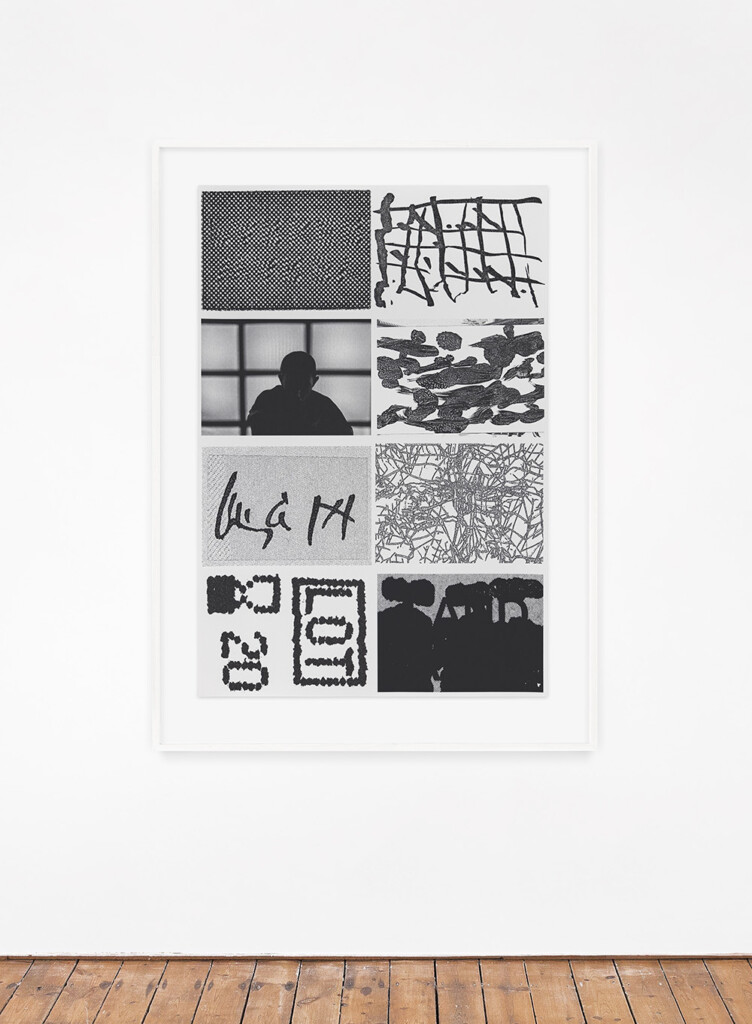
silkscreen print on archival paper, 30 × 44 in.
But if I start to examine things more closely, I can see a relationship between certain approaches or aesthetic sensibilities that I have in both my art practice and my graphic design practice. Like gravitating toward a certain formal starkness or austerity, or a level of high contrast (tonally, typographically, relationally between forms and elements), or even just a very granular level of detail.
The use of images is crucial to your work—both as a designer and visual artist—and you have specific ways that you use and manipulate them. We don’t have artworks or photographs in our poster, but you have almost treated “GSD” as an image and manipulated its presence in multiple cases. Can you talk about using images beyond their representational value?
I definitely seek out more formal and aesthetic ways to use images, or as elements that feel or act as texture or tone. Or maybe it’s just a desire to use them less conservatively. Having worked mostly in and around the world of contemporary art I’ve often bumped up against the preciousness or strictness that surrounds images. Rules like: no cropping, no altering, no going across a gutter, etc. I understand it of course, but it does make me want to rebel against those rules when the opportunity arises.
I’m also a big proponent of using type as image or type as texture. There’s a very type-centric or type-first mentality that’s pretty firmly embedded in the way I approach design, which definitely pushes me to be more inventive with type and to find certain type moves that can do some of the heavy lifting in terms of conveying ideas and content. That said, I’m often aiming to create typographic moments that feel very integrated (i.e., not just floating or slapped on top), and weighty, and iconic.
Repetition plays a large role in the posters, emails, and related materials for this year’s public programs. How did this come about as a visual device?
I started using repetition throughout the visual identity as a simple strategy to reference space, scale, and expansion, which of course felt very appropriate for a graduate school revolving around architecture and urban planning.
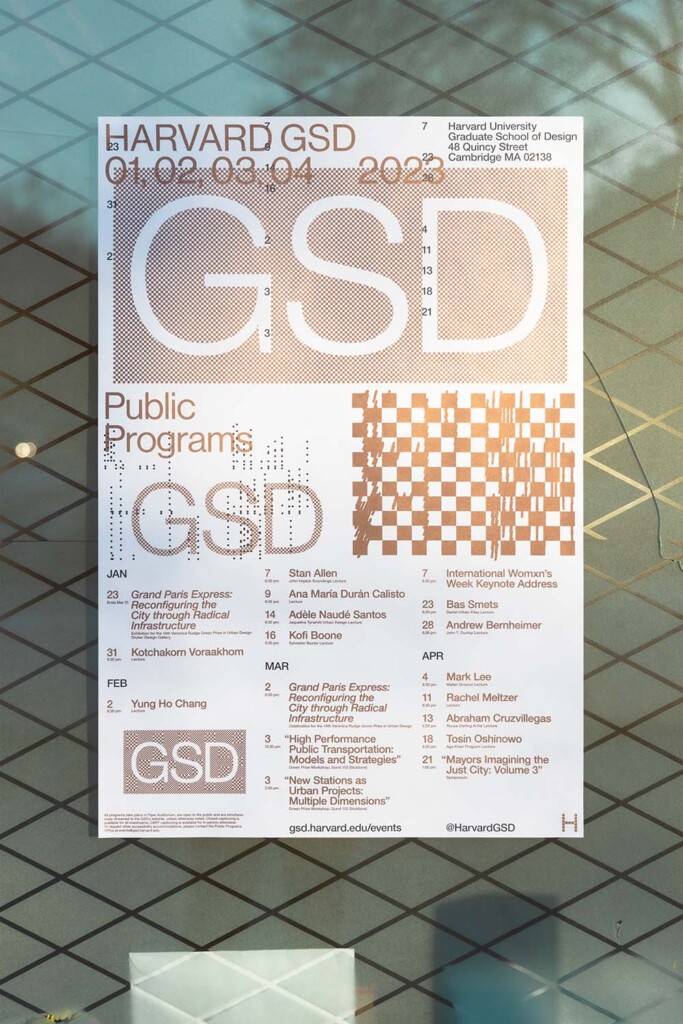
Repetition as a visual device most noticeably plays out within the poster where there are three relatively prominent “GSD” graphics that are descending in scale from top to bottom. I repeated the GSD “tag” not only to establish these different spaces or levels, but also to represent two ideas at the same time: the idea of ascension representing expansion or growth on the one hand, versus the idea of descension representing a zooming or zeroing in on the other.
The vertically stacked grid spaces on the poster also nest with or mirror this structure. Whereas the three “GSD” graphics are descending in scale from top to bottom, the vertically stacked grid spaces are ascending in their column structure from top to bottom starting with the one big “block” column on top, then the two “block” zones in the middle creating two columns, and finally the three columns of listings on the bottom of the poster.
The day numbers from the calendar are also repeated and overprinted on the top half of the poster. The core parts of the poster were already locked in this nesting, symbiotic structure, so I wanted to bring in a similar, connective gesture to reinforce the repetition. In this instance I felt that the overprinting red day numbers become more of a representation of time as a space, presence, or structure.
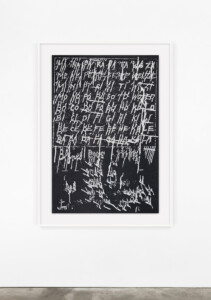
You have a wonderful sense for type and typeface choices. Even the simplest typeface, in the right hands, can be used to great effect. How do you go about choosing a typeface (our poster is set in Helvetica Neue) and then using it?
I love a simple typeface! To me there are some absolute classics that I would probably be happy to use forever. I feel fortunate that when I was first being introduced to typography that my instructors were showing me the work of a lot of amazing Dutch graphic designers. That had a major influence on me, and I definitely noticed the typefaces they used, the sort of calculated unfussy-ness of their approach to type, and even their loyalty to using just a handful of typefaces for all their projects, or even a single typeface.
Just some of the typefaces I’m thinking of are: Gothic LT 13, Grotesque MT, Univers LT, Akzidenz Grotesk, condensed cuts of Franklin Gothic, more obscure cuts of Times New Roman like MT or Eighteen, Gothic 720 BT, Pica 10 Pitch, Prestige Elite, AG Schoolbook, and of course Helvetica Neue, among many others.
As far as choosing a typeface goes, I like to keep that process simple as well. I think the width of the strokes are a major factor. Sometimes I’m trying to find stroke widths that feel in harmony with other elements like images, content, format, the proportions of the format, etc. But in other instances, it makes more sense for the stroke widths to have a lot of contrast or weight difference in comparison to the other elements. Lastly, I think the letters used in the main title of the design project play a big role in how I make my typeface selections.
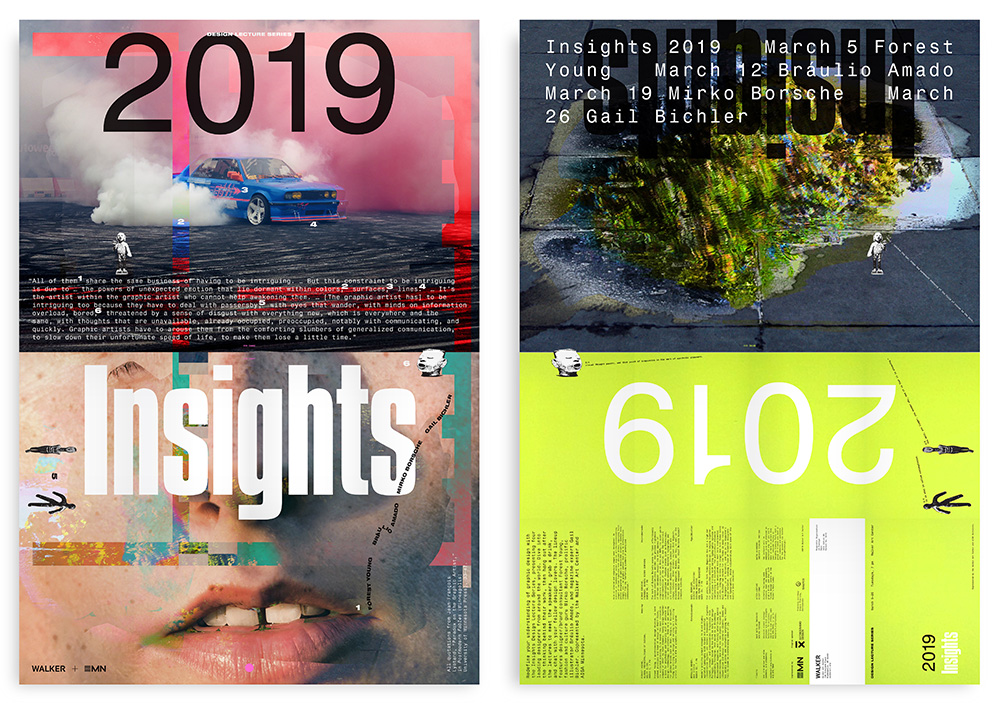
With the uppercase letters in “HARVARD GSD”, I’m primarily looking at the “R” and the “G”: both great letterforms that I happen to find pretty irresistible when they’re typeset in Helvetica Neue. With a Helvetica Neue “R”, it’s the curve of the leg. It’s a super elegant curve with a slight outward taper down on the baseline that I think sets Helvetica Neue apart. With the Helvetica Neue “G”, it’s almost all about that downward spur in the bottom-right of the letterform that’s perfectly balanced and gives the “G” such an iconic stance.
Had the main title of this project not included an “R” and a “G”, I’m sure I would’ve chosen a different typeface. It all comes back to content and what you’re working with—even down to the letters being used.
I don’t imagine you have a traditional studio structure as a designer, but the desk-job portion of running a studio is not something they teach in school. Is there any kind of learning curve when it comes to practicing design for clients and what it takes to “manage” a studio?
I think there can be a fairly steep learning curve considering that being an independent or small studio graphic designer can often require you to possess so many graphic design adjacent skills. You might only be working on actual graphic design for 20 percent of the time during a project, while the other 80% of the time is dedicated to aspects like pre-production, editing content, communicating with collaborators and vendors, ensuring quality final production, etc. Like you mention, design schools barely and sometimes never teach these aspects of graphic design to students, but they’re obviously important.
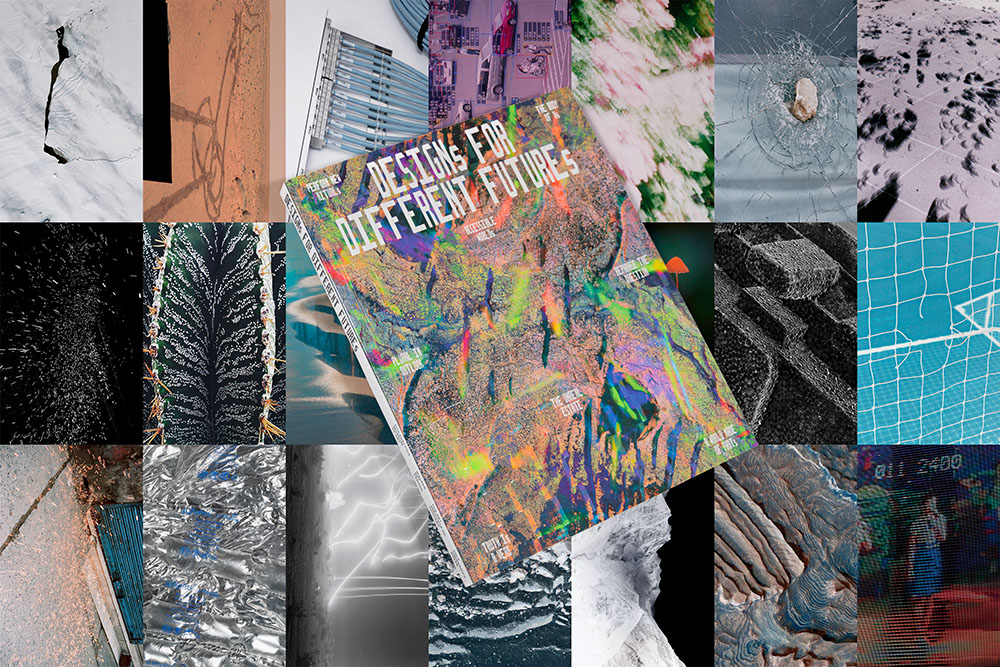
These types of skills tend to live in the background which is probably why they go untaught in design schools and, frankly, are not even spoken about very often. But I wouldn’t trade them for anything simply because skills like these give me the confidence to handle just about any project thrown at me and allow me to focus more on the actual graphic design.
